Vol. 71, No. 17 (2022)
2022-09-05
SPECIAL TOPIC—Frontiers in non-Hermitian physics
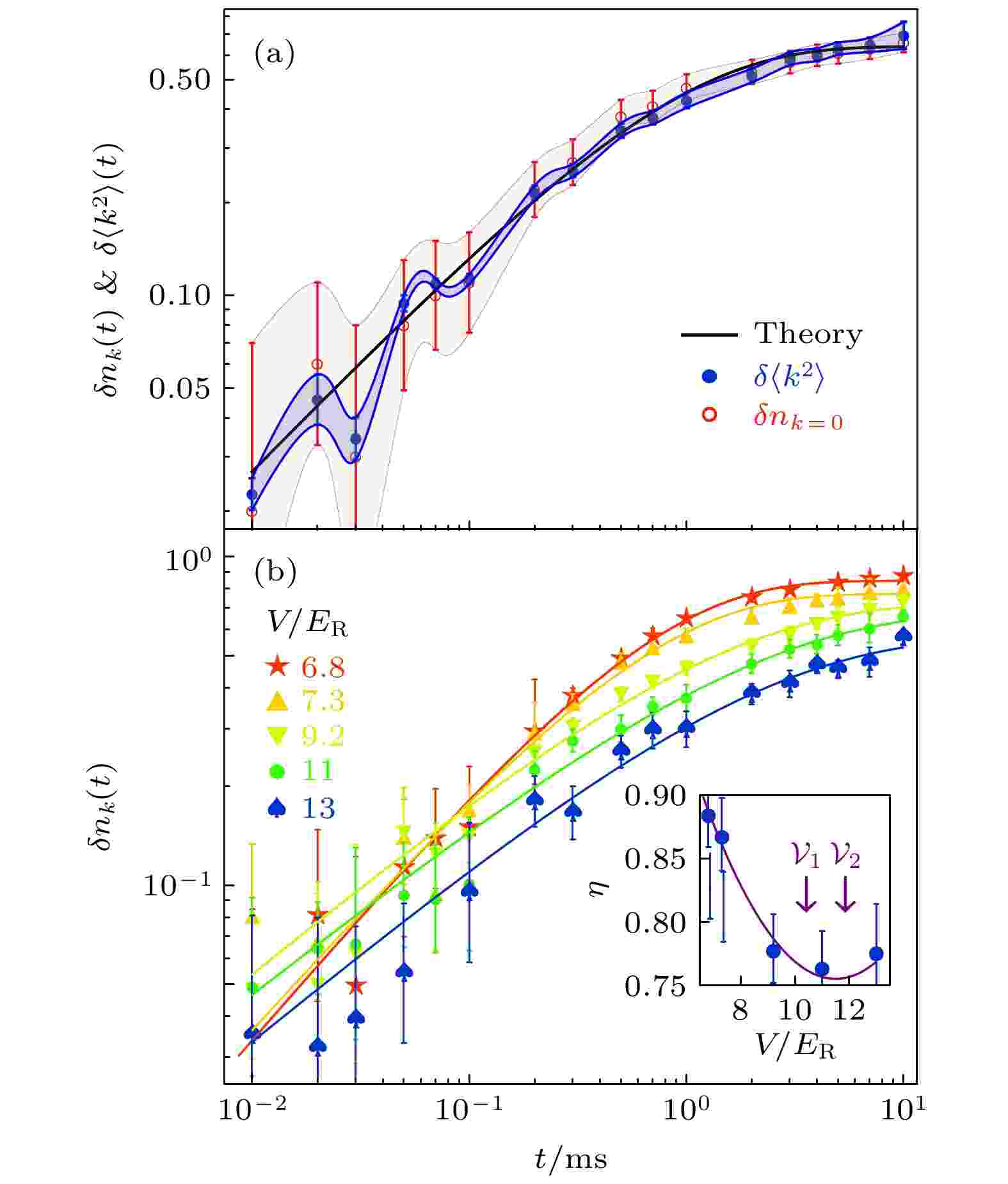
EDITOR'S SUGGESTION
2022, 71 (17): 170305.
doi:10.7498/aps.71.20220862
Abstract +
Linear response theory is the theoretical foundation of modern experiments. In particular, it plays a vital role in measuring quantum matters. Its main idea is to take the external probe signal of the physical system as a perturbation and use the correlation function in the unperturbed equilibrium state to depict the response to the observable in system. In recent half century, the linear response theory for the closed quantum system has achieved great success in experiments on quantum matters. In recent years, with the tremendous progress of the precise manipulation of the light-matter interaction, the ultracold atom experiments can precisely control dissipative quantum many-body systems. With the discovery of many novel phenomena, dissipative quantum systems and non-Hermitian physics have attracted extensive attention in theory and experiment. We developed a linear response theory, named non-Hermitian linear response theory, to deal with open quantum systems. This theory takes the non-Hermitian term and quantum noise, which are induced by dissipation, as an external perturbative input, to detect the properties of the quantum system, and relates the time evolution of the observable with the correlation function in the unperturbed state of the system. The non-Hermitian linear response theory provides a new method for distinguishing the exotic quantum phase from the normal phase. The theoretical predictions are highly consistent with the recent experimental results of cold atom systems. This paper will review the non-Hermitian linear response theory and discuss its applications in quantum many-body and time-reversal symmetric quantum systems.
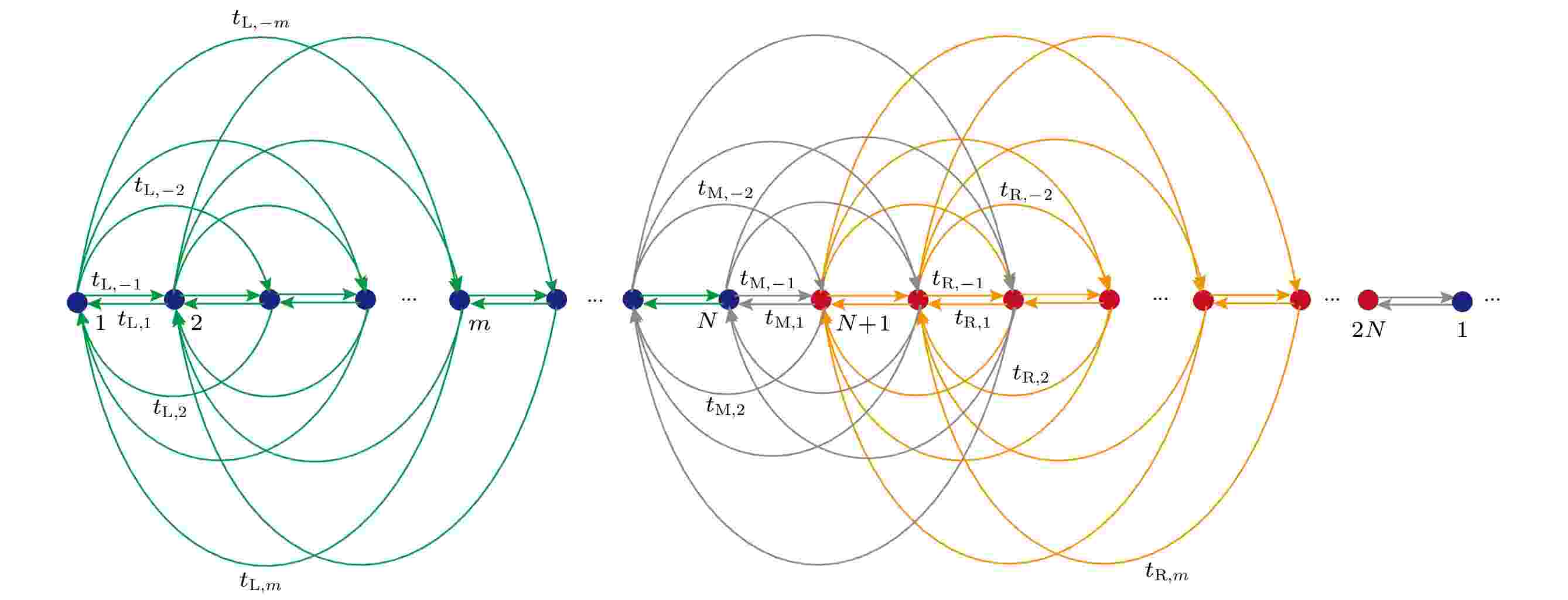
EDITOR'S SUGGESTION
2022, 71 (17): 170306.
doi:10.7498/aps.71.20221087
Abstract +
The non-Hermitian skin effect is one of the most striking features in non-Hermitian physics. It reveals a novel phenomenon in a non-Hermitian system that the bulk wave function and energy spectrum are sensitively dependent on the boundary conditions. The concept of generalized Brillouin zones has been proposed to characterize bulk wave functions in such systems . Based on generalized Brillouin zones, non-Bloch topological invariants can reconstruct the non-Hermitian bulk-edge correspondence. Previous discussion of the non-Hermitian skin effect mainly focused on open boundary conditions, and the calculation of generalized Brillouin zones needs to be reconsidered under domain-wall boundary conditions. The paper introduces the related researches of the non-Hermitian skin effect in domain-wall systems, including the general form of the generalized Brillouin zone equation in a one-dimensional single-band model, non-Bloch topological invariants in non-Hermitian SSH (Su-Schieffer-Heeger) model, and the experimental realization of the non-Hermitian skin effect in one-dimensional quantum walk system.
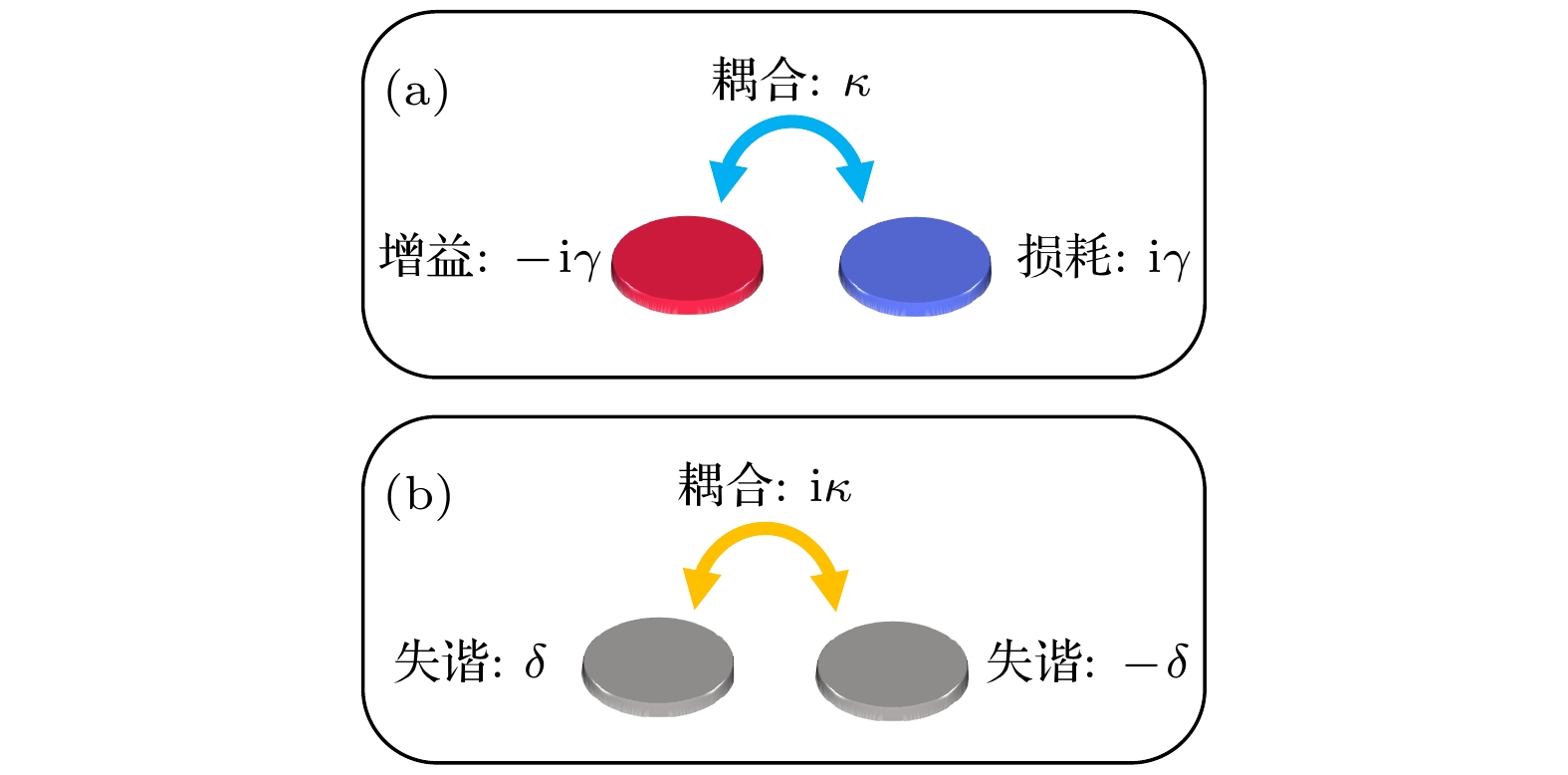
2022, 71 (17): 171101.
doi:10.7498/aps.71.20221323
Abstract +
In standard quantum mechanics, the Hamiltonian describing the physical system is generally Hermitian, so as to ensure that the system has real energy spectra and that the system’s evolution is unitary. In recent years, it has been found that non-Hermitian Hamiltonians with parity-time (
${\cal {PT}}$
) symmetry also have real energy spectra, and there is a novel non-Hermitian exceptional point between
${\cal {PT}}$
-symmetric phase and
${\cal {PT}} $
-symmetry-broken phase, which is unique to non-Hermitian systems. Recently, people have realized
${\cal {PT}} $
symmetric and anti-
${\cal {PT}}$
symmetric non-Hermitian Hamiltonians in various physical systems and demonstrated novel quantum phenomena, which not only deepened our understanding of the basic laws of quantum physics, but also promoted the breakthrough of application technology. This review will introduce the basic physical principles of
${\cal {PT}} $
symmetry and anti-
${\cal {PT}}$
symmetry, summarize the schemes to realize
${\cal {PT}} $
symmetry and anti-
${\cal {PT}} $
symmetry in optical and atomic systems systematically, including the observation of
${\cal {PT}} $
-symmetry transitions by engineering time-periodic dissipation and coupling in ultracold atoms and single trapped ion, the realization of anti-
${\cal {PT}} $
symmetry in dissipative optical system by indirect coupling, and realizing anti-
${\cal {PT}} $
-symmetry through fast atomic coherent transmission in flying atoms. Finally, we review the research on precision sensing using non-Hermitian exceptional points of
${\cal {PT}} $
-symmetric systems. Near the exceptional points, the eigenfrequency splitting follows an
${\varepsilon }^{\tfrac{1}{N}}$
-dependence, where the
$\varepsilon$
is the perturbation and
$ N $
is the order of the exceptional point. We review the
${\cal {PT}}$
-symmetric system composed of three equidistant micro-ring cavities and enhanced sensitivity at third-order exceptional points. In addition, we also review the debate on whether exceptional-point sensors can improve the signal-to-noise ratio when considering noise, and the current development of exceptional-point sensors, which is still an open and challenging question.
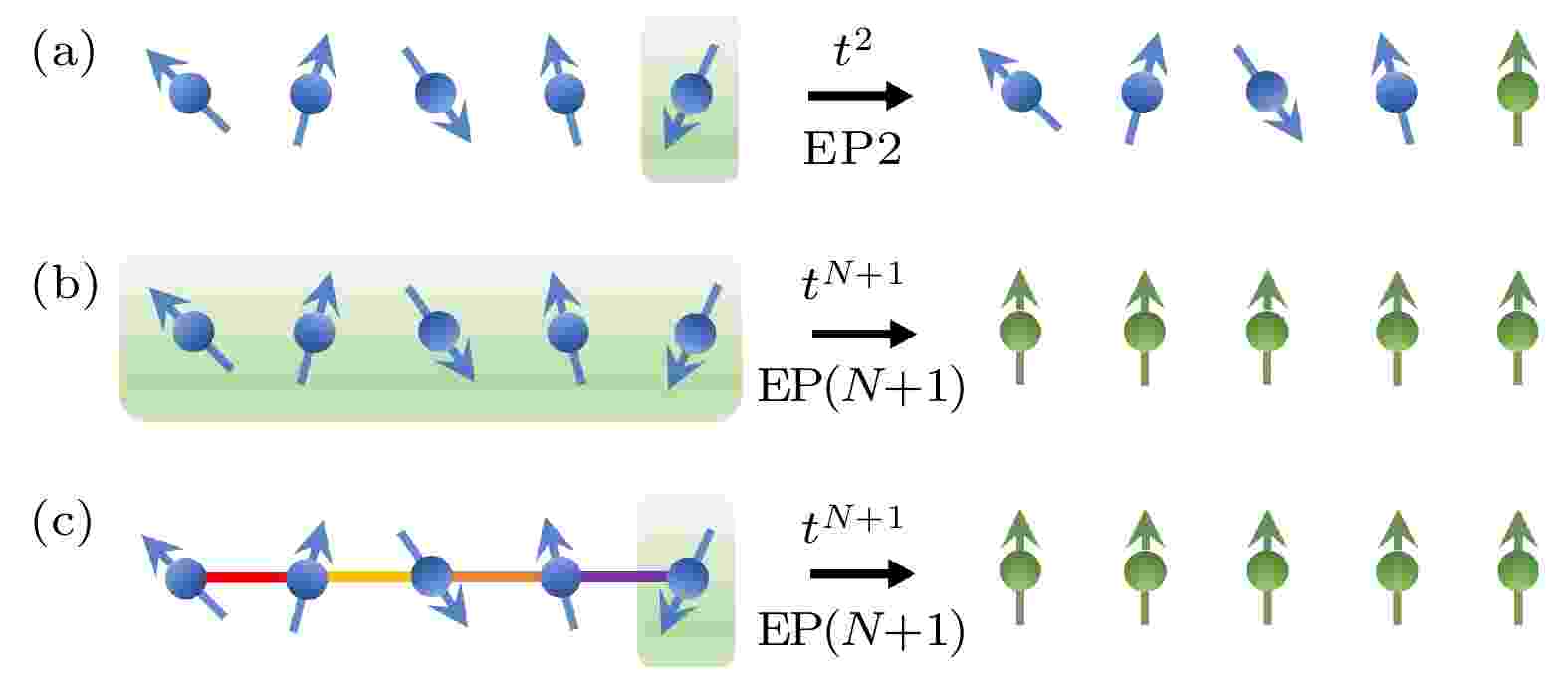
EDITOR'S SUGGESTION
2022, 71 (17): 174501.
doi:10.7498/aps.71.20220914
Abstract +
In recent years, two independent research fields, i.e. non-Hermitian andstrongly correlated systems have been merged, forming an important researchfield in physics. The progress of relevant theories and experiments hasreshaped our understanding of matter. In this field, the research object isnot limited to the influence of non-Hermiticity on the energy spectrum andthe eigenstate properties of many-body systems. Researchers have paid more attentionto the manipulation of quantum states. It is universally received that the exceptional point is the most significant featurethat distinguishes non-Hermitian quantum mechanics from Hermitian quantum mechanics. In addition to the recent advances in non-Hermitian topological band theory and quantum sensing around the exceptional points, this paper concentrates on the non-Hermitian critical dynamical phenomenon and its application to the quantum many-body system. When the system has an exceptional point, an arbitrary initial state belonging to the coalescent subspace will be projected on the coalescent state. Based on the directionality of the evolved quantum state, this paper reviews our several representative researches in recent years, including local-field-induced dynamical magnetization, quantum phase transition in transverse field, Ising model at non-zero temperature, quantum mold casting in the center-environment system, as well as superconducting state preparation in the non-Hermitian strongly correlated system. We also focus on the new preparation methods and detection schemes of non-equilibrium quantum states related to exception points.
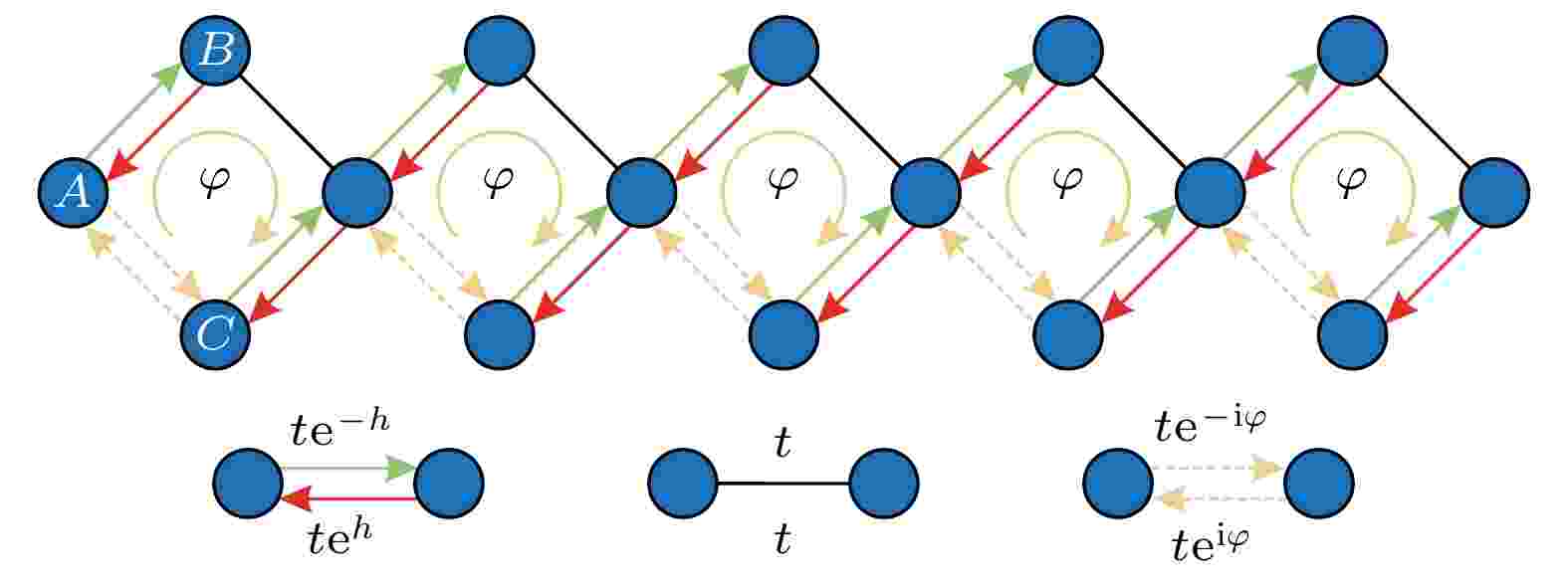
2022, 71 (17): 174201.
doi:10.7498/aps.71.20220978
Abstract +
The application of energy band theory in optics provides an effective approach to modulating the flow of light. The recent discovery of non-Hermitian skin effect promotes the development of traditional energy band theory, which further enables an alternative way to realize light localization and unidirectional propagation. However, how to effectively generate and steer the non-Hermitian skin effect is still an important topic, especially in integrated optical systems. Here, we investigate the non-Hermitian skin effect in quasi-one-dimensional rhombic optical lattice with synthetic gauge potential. By calculating the eigenenergy spectra, spectral winding number, and wave dynamics, the gauge potential can be utilized to effectively tune the localization strength of skin modes. In particular, the skin effect is completely suppressed when the gauge potential in each plaquette is equal to π, while the flat-band localization caused by Aharonov-Bohm caging effect is dominant. By utilizing the indirectly coupled micro ring resonator array, the gauge potential and asymmetric coupling can be generated at the same time, which provides a potential experimental scheme to explore the competition between Aharonov-Bohm cage and skin effect. The present study provides an alternative way to steer the skin effect, which offers an approach to achieving the on-chip non-magnetic unidirectional optical devices.

2022, 71 (17): 177302.
doi:10.7498/aps.71.20220796
Abstract +
The topological property and the energy property of one-dimensional non-Hermitian spin-orbit-coupled Su-Schrieffer-Heeger (SSH) model are investigated theoretically, by introducing spin-dependent imaginary potentials with gain and loss effects. It is found that the imaginary potential leads the imaginary energy spectra to appera in the topologically nontrivial region of this system, and the
${\cal {PT}}$
phase transition to happen in the topologically trivial region. In addition, the imaginary potential energy and spin-orbit coupling work together to make the topological phase transition occur in the topologically trivial region, and the topological non-trivial region becomes wider. The energy spectrum results show that the imaginary potential energy and the spin-orbit coupling can obviously control the zero-energy states of the system, which mainly lies in the presence of four zero-energy states with four different localities and numbers. This shows the special adjustment effect of imaginary potential energy and spin-orbit coupling on the energy band structure of the system. It is believed that these results are helpful in understanding the topological phase transition behavior of
${\cal {PT}}$
-symmetric non-Hermitian system.
SPECIAL TOPIC—Terahertz biophysics

EDITOR'S SUGGESTION
2022, 71 (17): 178702.
doi:10.7498/aps.71.20212419
Abstract +
Terahertz wave is an electromagnetic wave, whose wavelength is located between microwave wavelength and infrared wavelength. Based on low ionization and fingerprint characteristics, it has great potential applications in biomedical field, especially in the intraoperative localization and qualitative diagnosis of tumors. Glioma is the most urgent tumor for positioning qualitative diagnosis. Owing to its invasiveness and heterogeneity, it is easy to relapse after resection and has a significant influence on the nerve function of adjacent brain regions. Therefore, rapid determination of tumor boundary and pathological characteristics is an important prerequisite for accurate diagnosis, treatment and clinical research of glioma. Here, we summarize the biophysical technology of glioma diagnosis, and expound the new technique of terahertz wave and its research results in diagnosis of glioma. Furthermore, based on the research progress of integrated diagnosis of glioma histopathology and molecular pathology, we propose a hypothesis that different molecular subtypes of tumor tissue may have a consistent 'differential terahertz wave protein composition' of terahertz tumor subtype recognition mechanism. Finally, combining the biological characteristics of brain tissue and the potential of glioma marker detection in body fluids, we discuss the clinical application model and prospects of terahertz technologies in glioma detection.
REVIEW
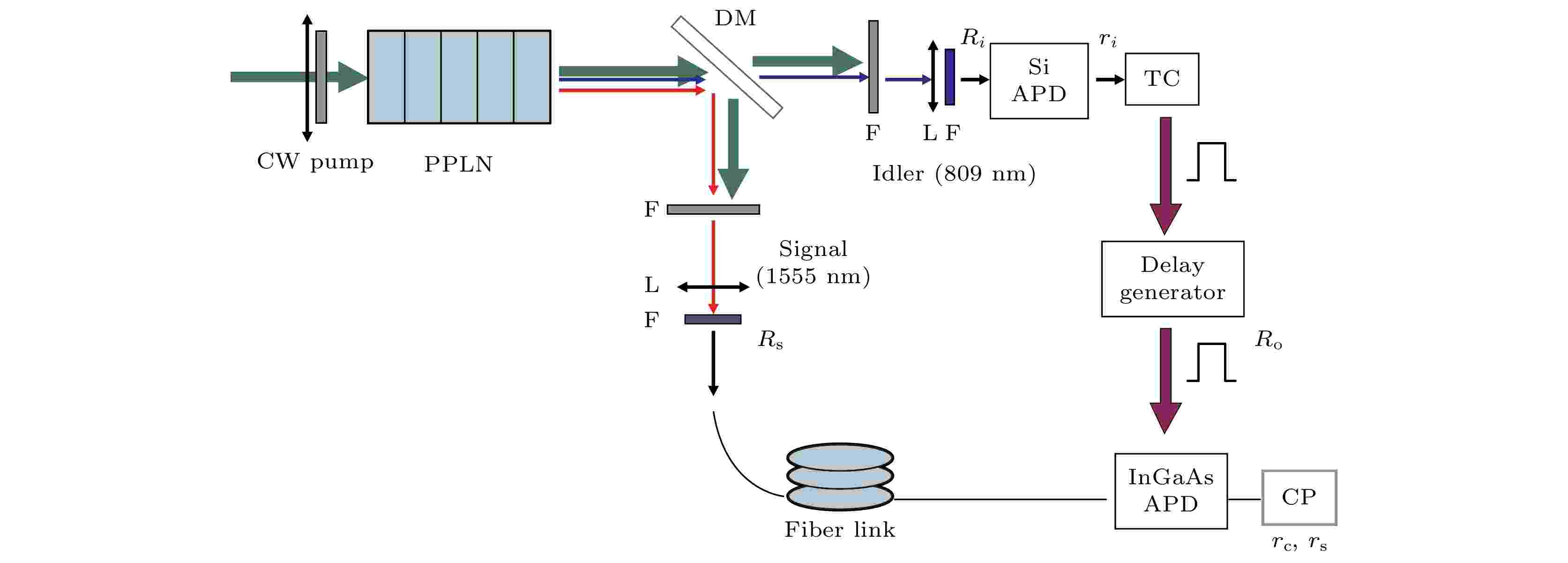
EDITOR'S SUGGESTION
2022, 71 (17): 170304.
doi:10.7498/aps.71.20220344
Abstract +
In this paper, we mainly introduce the preparation and physical properties of the heralded single-photon source, the development history and its applications in three typical quantum key distribution protocols, including BB84, measurement-device-independent and twin-field quantum key distribution protocols. Moreover, we make comparisons of the above quantum key distribution protocols between using heralded single-photon source and using weak coherent sources, and analyze their advantages and disadvantages. Besides, according to the characteristics of single-photon interference in twin-field quantum key distributions, the limitations of separately applying heralded single-photon sources to twin-field quantum key distributions are revealed, and possible solutions are discussed. Therefore, this work may provide valuable references and help for the practical implementation of quantum secure communication in the near future.
GENERAL
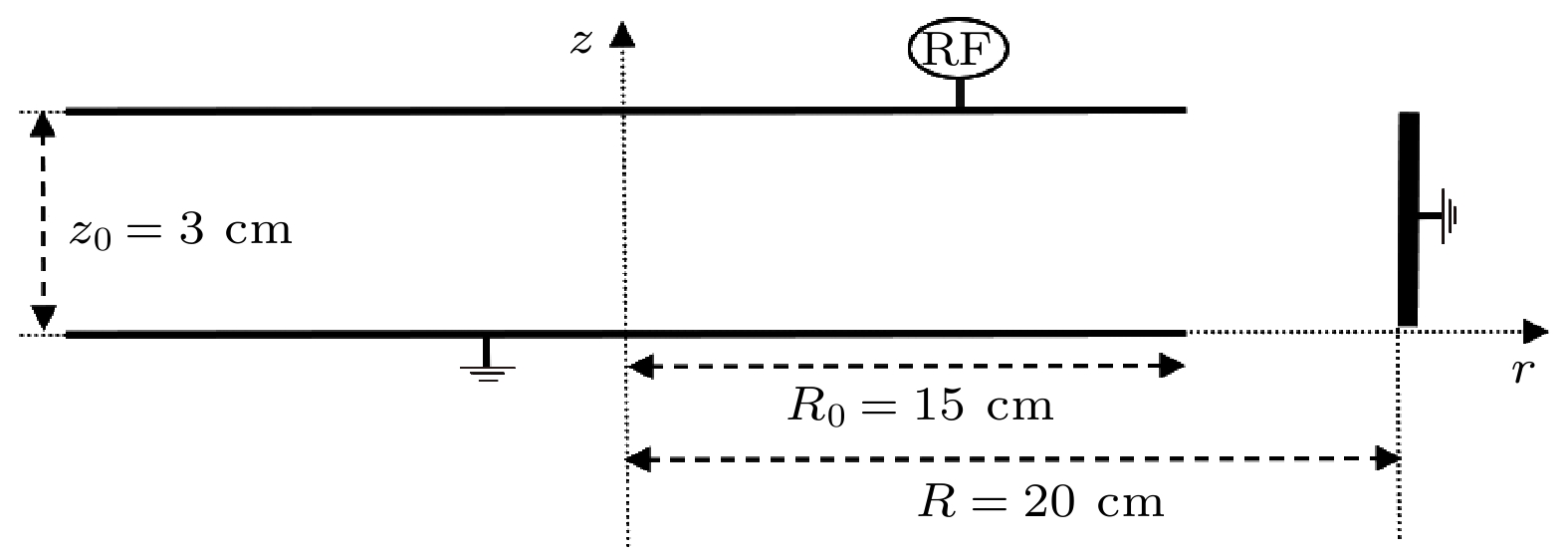
EDITOR'S SUGGESTION
2022, 71 (17): 170201.
doi:10.7498/aps.71.20220493
Abstract +
Higher requirements for the performances of thin films need to be fulfilled in the rapid development of integrated circuit technology, due to the more complicate structure and smaller size of chips. In plasma-enhanced chemical vapor deposition , high-density and high-performance thin films can be deposited at low temperature, compared with traditional chemical vapor deposition. In this work, a two-dimensional fluid/MC model coupled with the deposition module is used to describe the capacitively coupled SiH4/N2O/Ar discharges as well as the deposition processes, focusing on the influences of the radial position, gas ratio and gas pressure on the deposition of silicon oxide films. The results show that the edge effect which leads the plasma density to rise near the electrode edges gives rise to the non-uniform deposition rate along the radial direction. It is also found that the more N2O and less Ar content in the gas mixture, as well as an increased gas pressure will improve this uniformity. However, an excessive deposition rate will lead to a series of undesirable phenomena, such as “key hole structure”, vacancies and excessive impurities in films. These problems are also troublesome in the microelectronics manufacture processes. More detailed investigation into the deposition mechanism can be expected in the future .

2022, 71 (17): 170301.
doi:10.7498/aps.71.20220669
Abstract +
Ligand decoration of noble metallic nanoparticles is often needed for some applications, such as biochemical sensing, catalysis and nanotechnology, and the understanding of its process is of great importance. The second harmonic scattering (SHS) technique with advantages of surface-sensitivity and label-free detection, provides intrinsic information for such a research. In this work, the second harmonic(SH) scattering patterns of two types of ligands (cetyltrimethylammonium chloride and L-cysteine) capped gold nanoparticles (GNPs) with the same radii are measured. Both the intensities and shapes of the SH scattering patterns are changed after the ligand exchange process. In order to explain the pattern changes, the analytic expressions of SH scattering are derived theoretically for a relatively large nanoparticle based on Dadap’s multipolar theory. Considering the derived relationship between the multipole (up to octopole) contributions and the power of the nanosphere radius, the effective size effect is introduced to express the SH scattering signal change for different ligand decorations and well explain the experimental results. This theory provides a new perspective of the SH scattering response to different capping ligands and offers a possible quantitative method to analyze interface physical chemistry for ligands on the surface of nanoparticles.
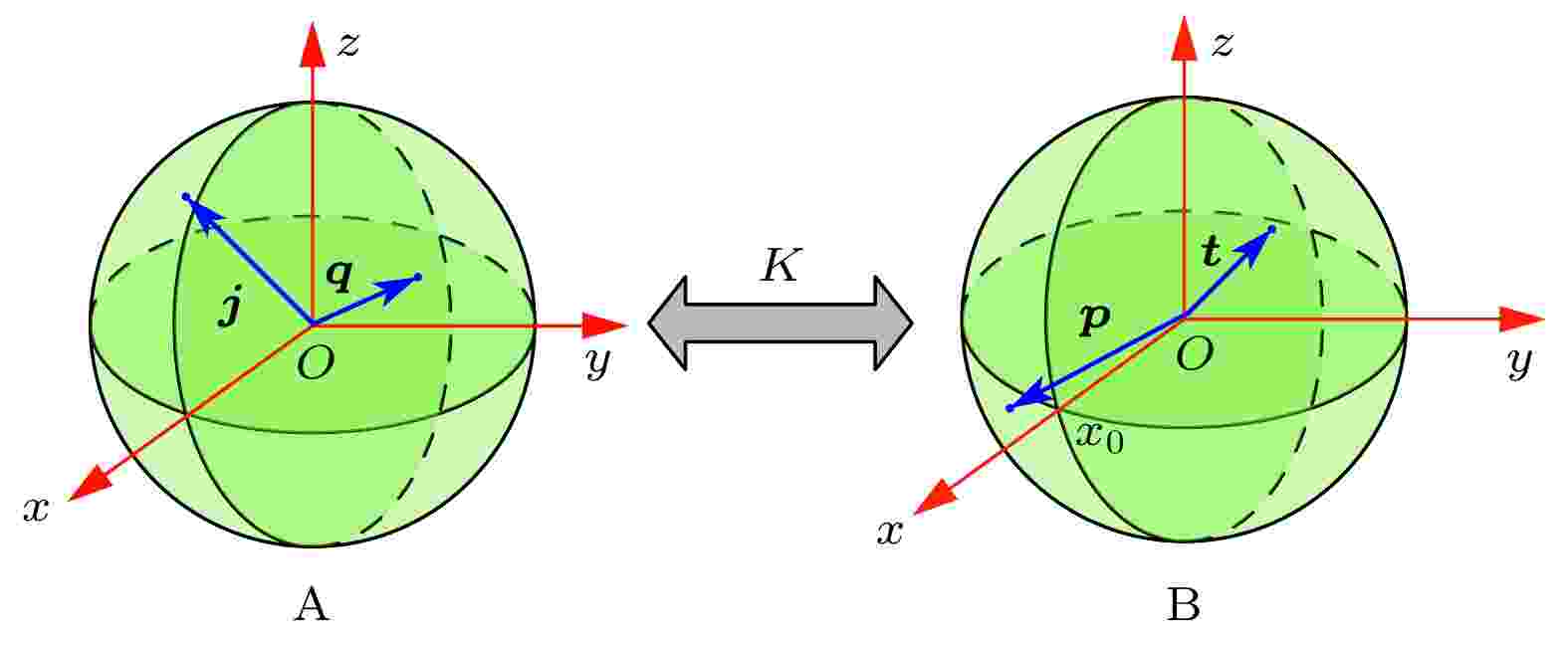
2022, 71 (17): 170302.
doi:10.7498/aps.71.20220445
Abstract +
Quantum nonlocal correlation is one of the important features that distinguish the quantum theory from classical theory. As a typical quantum mixed state, the study of quantum nonlocal correlation based on the “X” state is of great importance for the verification of the correctness of quantum theory and the application of quantum information theory. In this work, with the traditional Clauser-Horne-Shimony-Holt (CHSH) inequality testing for quantum nonlocal correlations, we propose a strategy for testing the quantum nonlocal correlations based on the geometric interpretation of the “X” state. By using the geometric interpretation of the “X” state, which is described by the transform of Bloch sphere, it is possible to investigate the optimal selection of measurement settings. The maximum value of CHSH inequalities can also obtained from the physical images. Finally, the range of parameters for a successful quantum nonlocal correlation testing based on the CHSH inequality for the “X” state is studied. The results show that when
$f = 1$
, the “X” state will be reduced to a normal pure entangled state, and the quantum nonlocal correlation testing results are in full agreement with the traditional ones. This result proves the correctness of the geometric interpretation strategy proposed in this work. When
$f \lt 1$
, only some of the “X” states can be used for e successfully testing the quantum nonlocal correlations. It is also found that the range of fidelity values that can successfully test the quantum nonlocal correlations will be further increased by increasing the values ofr. In particular, whenr= 1, the range of fidelity value will reach a largest one (e.g.
$f \gt 0.781$
). The results in this work can provide the reference for experimentally testing the quantum nonlocal correlation by using the “X” state.
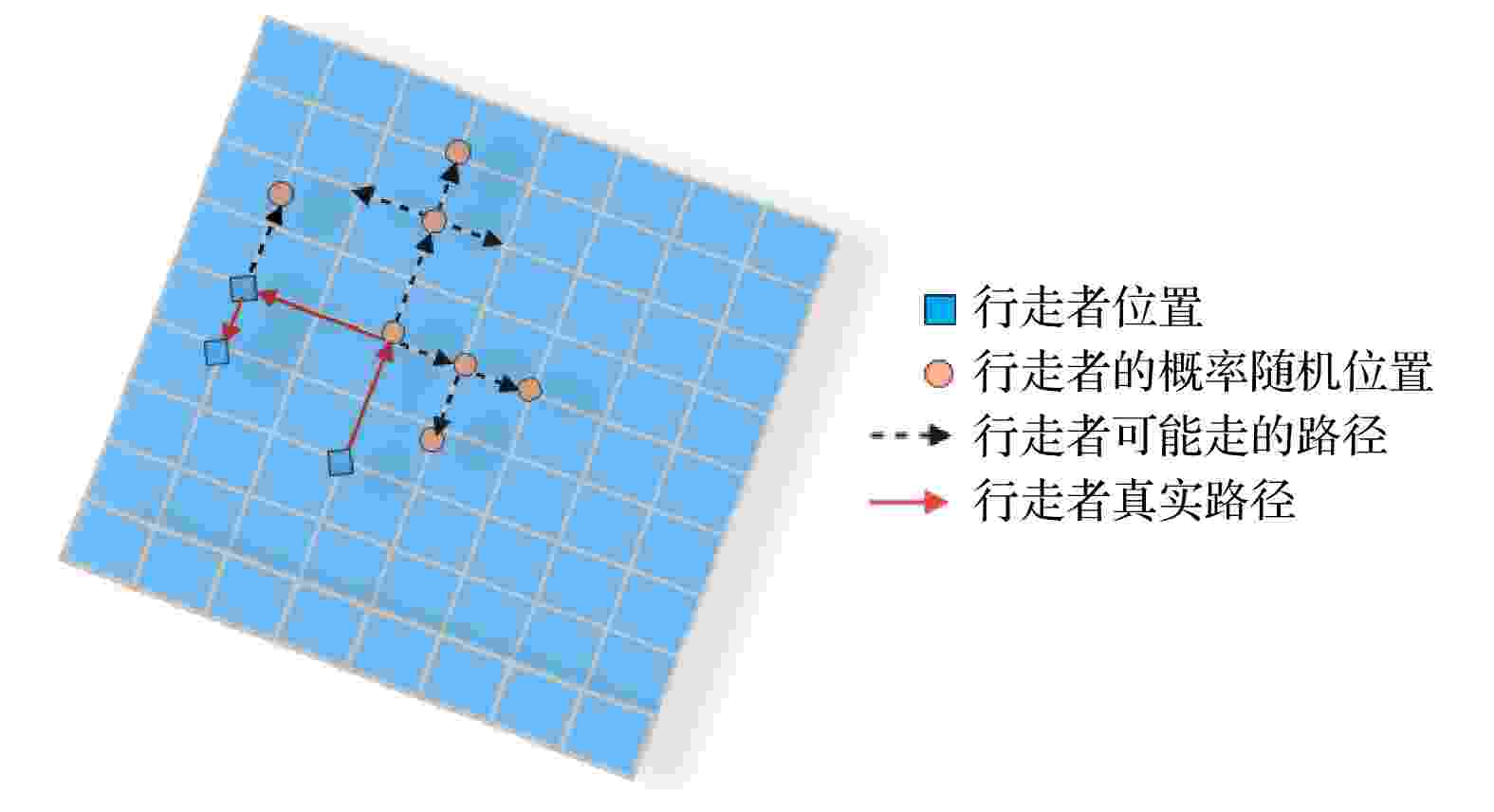
Three dimensional image encryption algorithm based on quantum random walk and multidimensional chaos
2022, 71 (17): 170303.
doi:10.7498/aps.71.20220466
Abstract +
With the development of computer network technology, people’s requirements for information security is increasing day by day. However, the classical encryption technology has the defects of small key space and easy crack. The problems of image encryption technology in protecting image information security and private content need solving urgently. As a new type of quantum key generator, quantum random walk has a large key space. Compared with the classical random walk, the computing speed and security are significantly improved. This paper presents a three-dimensional image encryption algorithm that is based on quantum random walk and involves Lorenz and Rossler multidimensional chaos. Firstly, Gaussian pyramid is used to segment the image. Secondly, the Hamming distances of several sub images are calculated by using the random sequence generated by quantum random walk and the random sequence generated by Lorenz chaotic system in multi-dimensional chaos, and then synthesized, and the Euclidean distances between the three RGB channels of the image are calculated. Finally, the sequence value obtained from the remainder of Hamming distance and Euclidean distance, as an initial value is input into the Rossler system in multi-dimensional chaos to generate a random sequence which is used as the key to XOR the RGB channel of the image so as to create an encrypted image. The corresponding decryption scheme is the inverse process of the encryption process. In addition, in terms of transmission security, this paper uses a blind watermark embedding algorithm based on DCT and SVD to embed the watermark information into the encrypted image, so that the receiver can extract the watermark and judge whether the image is damaged by the attack in the transmission process according to the integrity of the watermark information. If it is not attacked maliciously, the image will be decrypted. This operation further improves the protection of image information security.The experimental results show that the peak signal-to-noise ratio of the encrypted image is stable between 7 and 9 and the encryption effect is good, the GVD score is close to 1, the correlation of the encrypted image is uniformly distributed, and the correlation coefficient is close to 0, and the key space is 2128in size and the encrypted histogram is evenly distributed, showing a high ability to resist statistical analysis attacks.
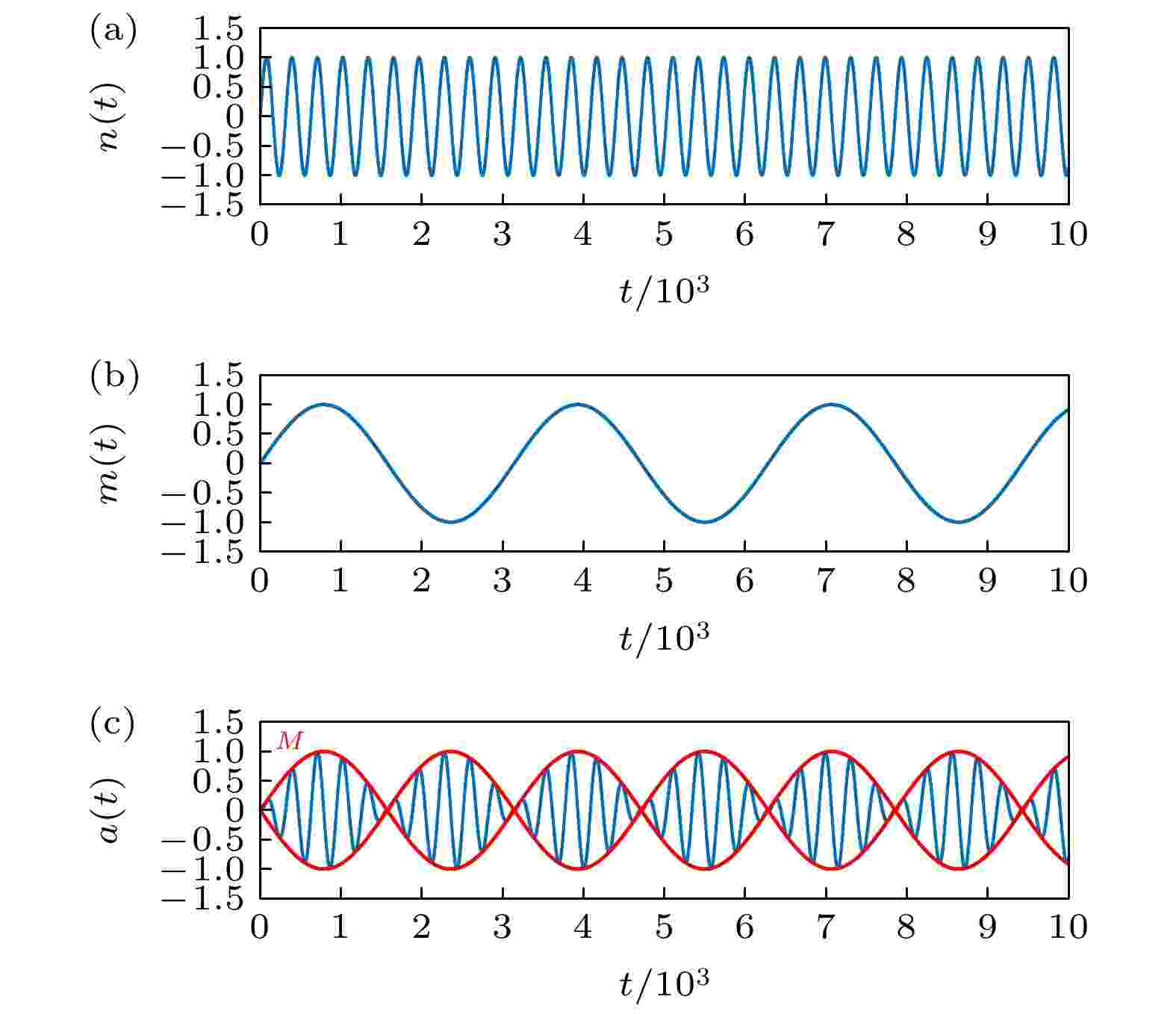
2022, 71 (17): 170501.
doi:10.7498/aps.71.20220514
Abstract +
The non-stationary characteristics of the climate system have been widely recognized. The occurrence of this non-stationary phenomenon is caused by the hierarchical structure of the climate system. As a high-level system, the external driving forcing changes with time, which leads to the non-stationary phenomenon of atmospheric movement. Slow feature analysis (SFA) method can extract the slow-changing features from fast-changing non-stationary signal. The SFA has been applied to attribution analysis of the climate system. In this paper, we use the SFA method to extract the driving force signal from the non-stationary time series obtained by the Henon mapping model to test its extraction capability. Then we extract the external driving force signal from Beijing monthly average temperature time series, and analyze the scale characteristics and physical mechanism of external driving forcing signals combined with wavelet transform. The results show that the long-period external driving forcing signal and the short-period external driving forcing signal jointly work on the climate system. At the same time, the long-period external driving forcing signal also works on short-period external driving forcing signal. This work contributes to understanding the hierarchical characteristics of the climate system.
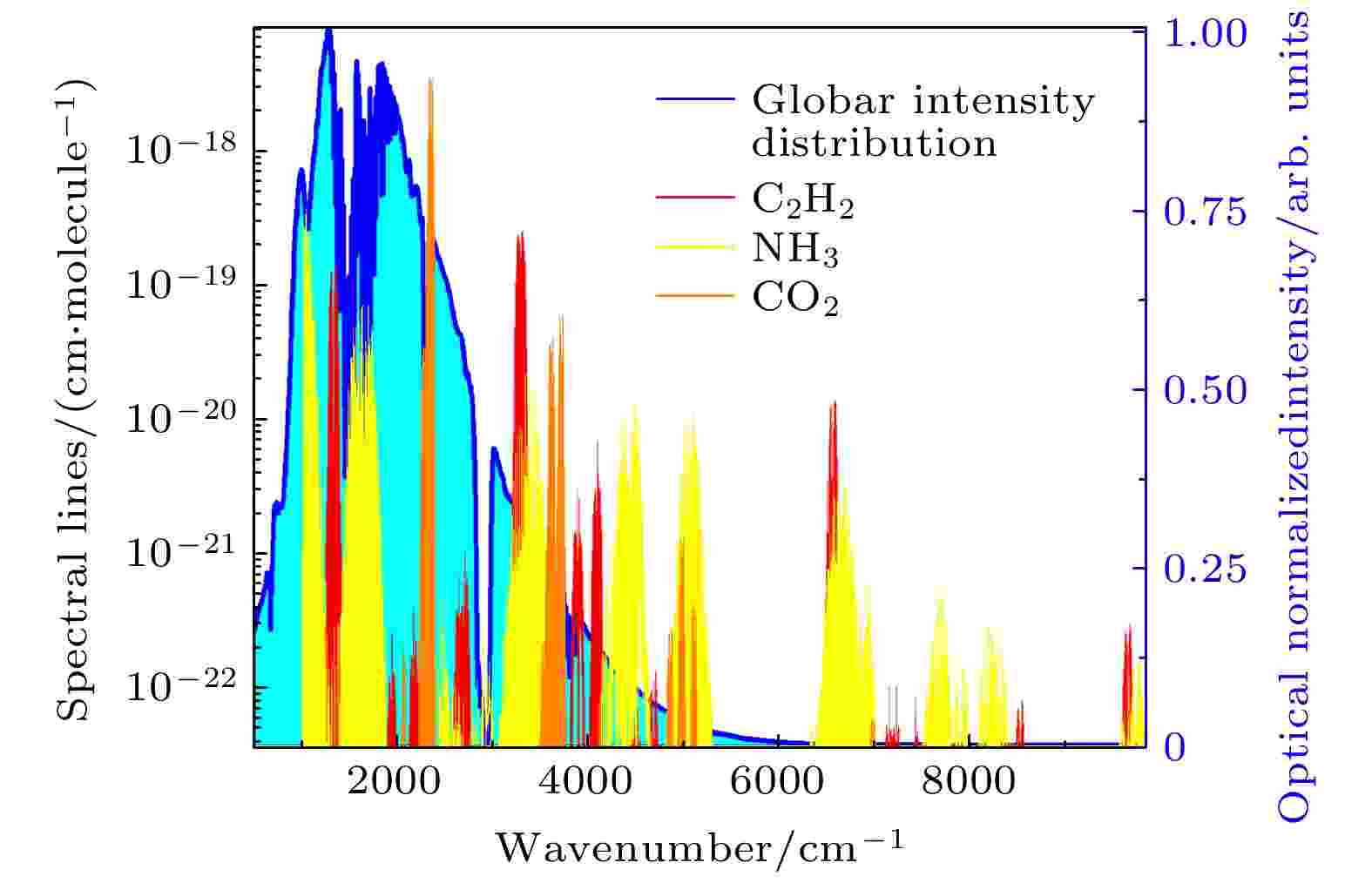
2022, 71 (17): 170701.
doi:10.7498/aps.71.20220613
Abstract +
The determination of toxic or harmful gases in industrial parks is a challenge to monitoring exhaust contaminants due to the features of complex compositions and ubiquity. Blackbody sources play an important role in simultaneously detecting the multiple gas species in the presence of cross-interfering absorption lines due to their effective ultra-wide wavelength range. Nevertheless, the problem of lower intensity per wavelength and less stability persists as an obstacle for highly sensitive trace gas detection. In this study, a dual optical path (DOP) enhanced differential photoacoustic and spectral detection mode is developed for simultaneously detecting the multiple toxic or harmful gas through augmenting the weak effective absorption signals and suppressing the spurious coherent background noise. Two identical T-type photoacoustic resonators are introduced to enable the differential mode. Neverthelss, the pure optical approach cannot distinguish the absorption characteristics of acetylene (C2H2) with volume fraction 5 × 10–5even with the DOP enhancement, whereas emerging peaks in the differential photoacoustic (PA) mode reveal the capability of PA spectroscopy to suppress coherent noise. The results demonstrate that the differential PA signal is improved by 1.91 times that obtained by the DOP design. Methane (NH3), acetylene (C2H2) and carbon dioxide (CO2) are used to verify the performance of this DOP enhanced differential PA gas sensor, and the volume fraction of the sensitivity is found to be 7.25 × 10–7for CO2, 1.84 × 10–6for C2H2, and 1.43 × 10–6for NH3at standard temperature and pressure, which is an order of magnitude higher than the original single mode PA value. Linear PA amplitude responses ranging from 0 to 3 × 10–3in volume fraction with respect to the three target gases are observed, and the correction coefficients are all greater than 0.995. The DOP enhanced differential PA detection mode compensates for the weakness of the limited sensitivity associated with broadband spectroscopic methods based on blackbody radiator. Thus, the broadband DOP enhanced differential photoacoustic modality is demonstrated to be an effective approach to simultaneous, highly sensitive and selective detection of multiple trace gases.

EDITOR'S SUGGESTION
2022, 71 (17): 170702.
doi:10.7498/aps.71.20220594
Abstract +
The quantum microwave measurement technology based on Rydberg atoms has developed rapidly and received widespread attention. It has shown significant advantages such as probe size independent of wavelength and broad spectrum measurement. Fiber-coupled vapor cell probe is one of the key technologies for portable quantum microwave measurement systems. The existing two-port fiber-coupled probe shares the graded index (GRIN) lens and optical fibers for outputting detection light with inputting coupling light, which limits light transmission efficiency of the detection light to 17%. Under these conditions, the power of the inputting detection light must be increased to ensure sufficient power to output the detection light, causing the electromagnetically-induced transparency (EIT) spectrum to broaden to 11 MHz, ultimately resulting in reduced measurement sensitivity. In this work, we propose a three-port fiber-coupled atomic gas chamber probe with an integrated dichroic mirror. On condition that the detection light and coupling light are transmitted in opposite directions and overlap in the vapor cell, the outgoing detection light is separated into two beams; one goes to an individual GRIN lens and the other to the output fiber, and the detection light transmission efficiency is 40.4%, and the half-height width of the EIT spectrum is reduced to 6 MHz. The probe is used to measure the microwave electric field intensity and phase; its effectiveness is verified by its ability to receive QPSK, 16QAM digitally modulated signals.
ATOMIC AND MOLECULAR PHYSICS
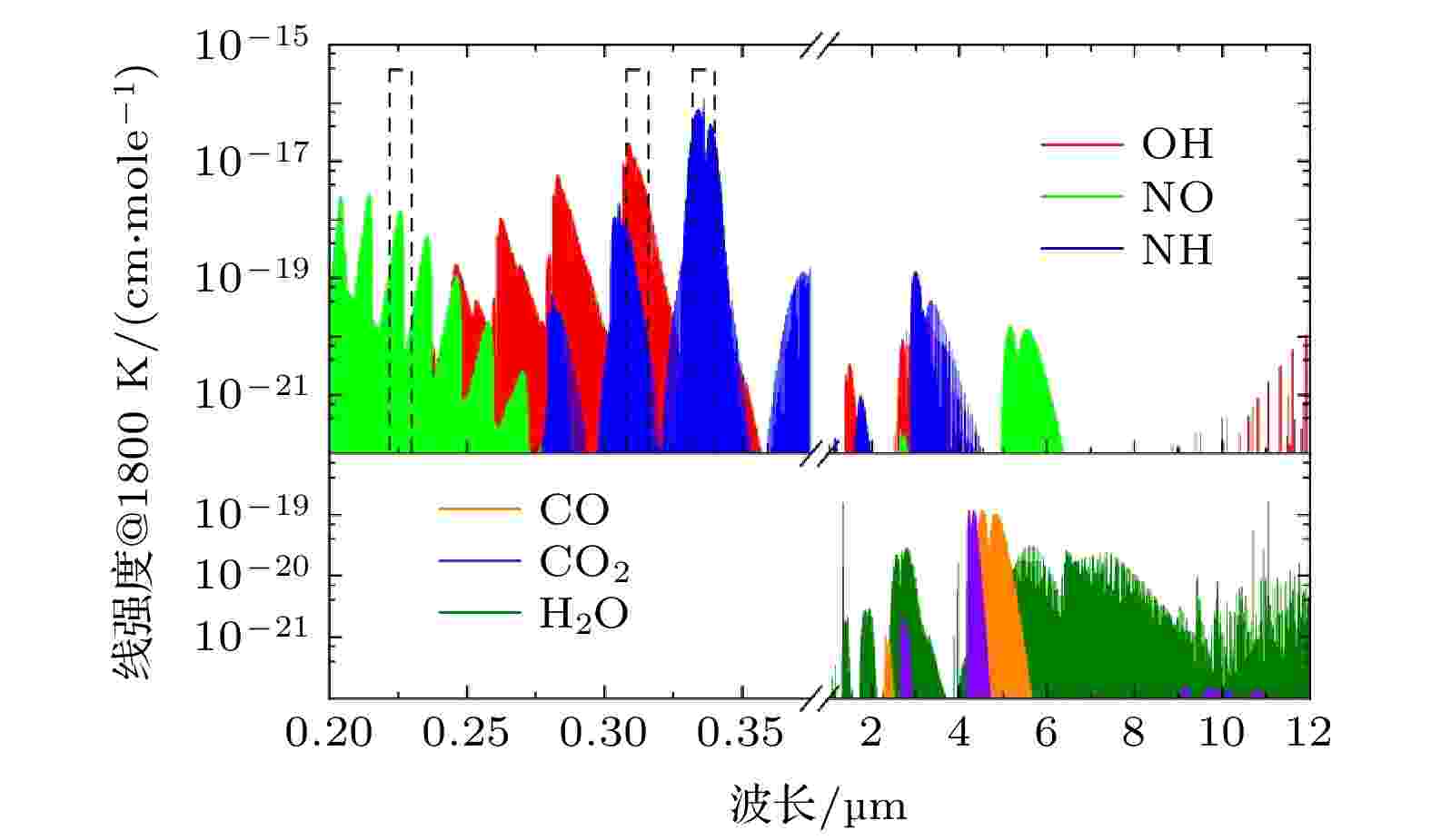
EDITOR'S SUGGESTION
2022, 71 (17): 173301.
doi:10.7498/aps.71.20220208
Abstract +
Temperature is an important parameter influencing the combustion reaction path and rate and determining the combustion and energy exchange efficiency. The OH, NH, NO and other species are involved in the key elementary reactions of combustion and determine the generation of NOxpollutants. Therefore, temperature and concentration measurements of OH, NH, and NO are of great significance for combustion diagnostics and research on reaction or emission mechanisms. In this work, a measurement system with high spatial resolution based on broadband ultraviolet absorption spectroscopy is established to realize simultaneous measurements of the temperature and concentrations of OH, NH, and NO in flames. Low detection limits of these three species are achieved by using the established measurement method. The 1σdetection limit of NH is 1.8 ppb·m (1560 K), which is realized for the first time in atmospheric-pressure flames using absorption spectroscopy. The 1σdetection limits of OH and NO are 60 ppb·m (1590 K) and 1 ppm·m (1380 K), respectively, which are obviously better than the existing results obtained by using infrared laser absorption spectroscopy. Then, the distributions of temperatures and concentrations of OH, NO and NH are acquired at various heights in an atmospheric-pressure NH3/CH4/air premixed flat flame with a high spatial resolution of nearly 0.1 mm. The broadband absorption spectra of OH and NH are acquired simultaneously inside the flame front, and the spectra of OH and NO are acquired simultaneously above the flame front. Inside or near the flame front, the temperatures deduced from the spectra of OH, NH, and NO are consistent, verifying the ability of these three species to be used to measure temperature. In addition, OH, NH, and NO are found to be suitable for different regions in combustion. The OH absorption is suitable for the post-combustion region with temperatures higher than 1000 K, the NH absorption can be used to acquire the temperature inside the flame front in complex combustion, and the NO absorption was able to provide the temperature in the region before or outside combustion at lower temperatures. Additionally, the experimental temperature and concentration profiles are in good agreement with the computational fluid dynamics predictions based on the mechanism, exhibiting the accuracy of the simultaneous temperature and concentration measurements by using broadband ultraviolet absorption spectra. Moreover, the differences in temperature and OH concentration between experiments and simulations indicate that the carbon sub-mechanism in the mechanism given by Okafor et al. [Okafor E C, Naito Y, Colson S, Ichikawa A, Kudo T, Hayakawa A, Kobayashi H
2018
Combust. Flame
187185
] should be further improved for more accurate predictions of NH3/CH4combustion.
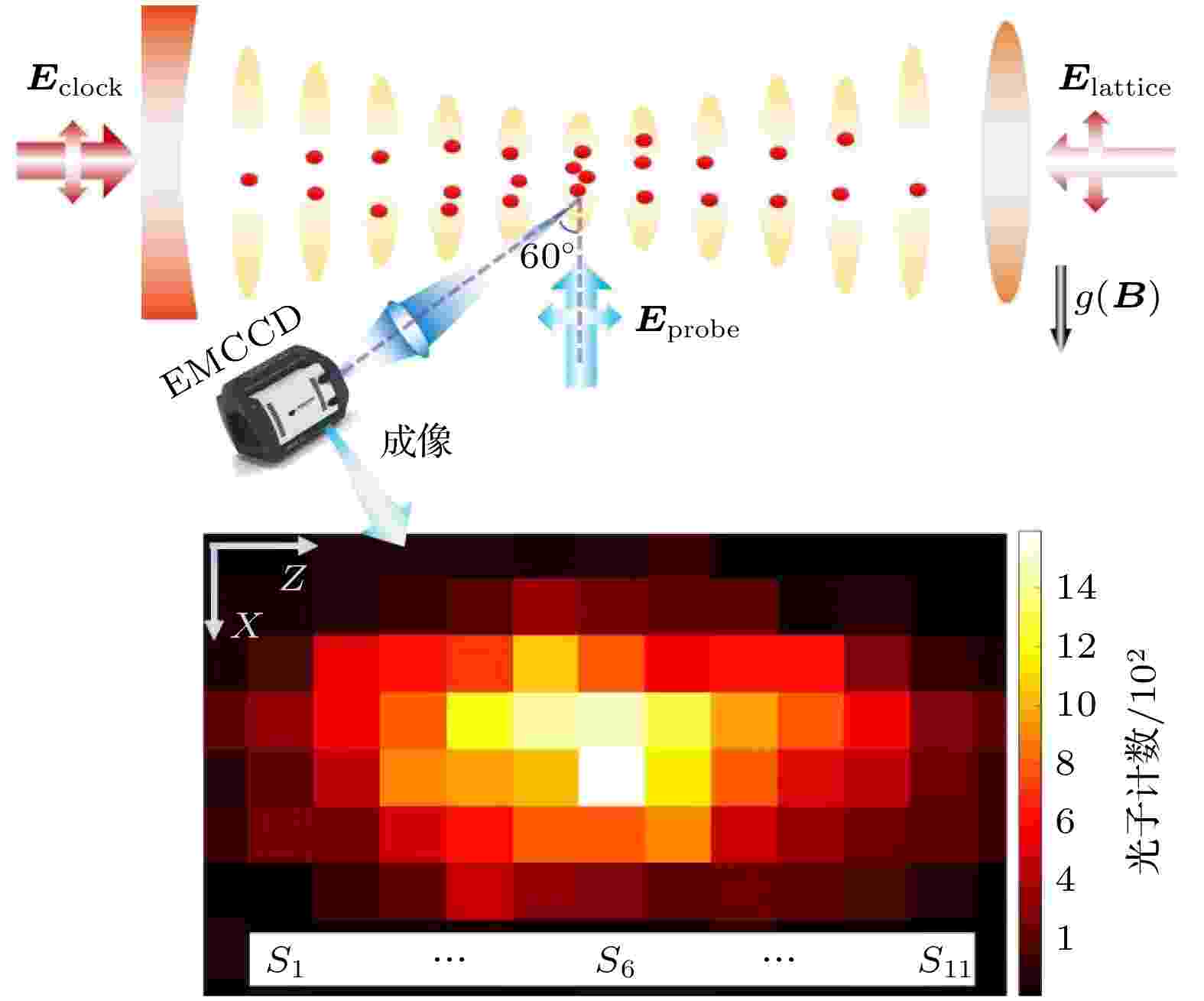
2022, 71 (17): 173401.
doi:10.7498/aps.71.20220600
Abstract +
Precision measurement of the density shift caused by the interaction among neutral atoms trapped in an optical lattice has important applications in the study of multi-body interaction and the realization of high-performance optical lattice clocks. The common methods of measuring the density are the self-comparison technique and frequency comparison between two optical lattice clocks. Both methods are based on the identical density shift coefficient and should interrelatedly operate the clock at high- and low-density state, respectively. The precision of self-comparison method is limited by the Dick effect. The synchronous frequency comparison between two optical lattice clocks can realize the precision beyond the Dick limit. However, both methods can only obtain the average density shift and ignore the fact that the magnitude of the density shift is different over the lattice sites as inhomogeneous density distribution in the lattice. In this paper, the synchronous frequency comparison technique based on in situ imaging is used to accurately measure the density shift coefficient of optical lattice clock. Atoms in the optical lattice are simultaneously and independently excited by the same clock laser beam, and the clock transition probability of 11 uncorrelated regions of the optical lattice is simultaneously detected by in situ imaging. Thus, the clock laser noise, which is the root cause of the Dick effect, is common-mode rejected as the frequency difference between uncorrelated regions is measured by the clock transition spectrum. Beyond the Dick-noise-limited stability, the stability of synchronous frequency comparison between uncorrelated regions is consistent with the limit resulting from the atom detection noise. Between the center and margin of the lattice, the differential shifts of the black-body radiation shift, lattice AC Stark shift, probe Stark shift, DC Stark shift, and quadratic Zeeman shift are all below 5 × 10–6Hz, which is three orders of magnitude smaller than the density shift and can be ignored in this experiment. Benefitting from the inhomogeneous distribution of atom number and negligible external field gradient in the optical lattice, the compared frequency shift between uncorrelated regions indicates the density shift. By measuring the relationship between the density shift and atom difference, the density shift coefficient is determined as –0.101(3) Hz/atom/site (with a measurement time of 103s), and the fractional measurement uncertainty of the mean density shift of our system is 1.5 × 10–17.
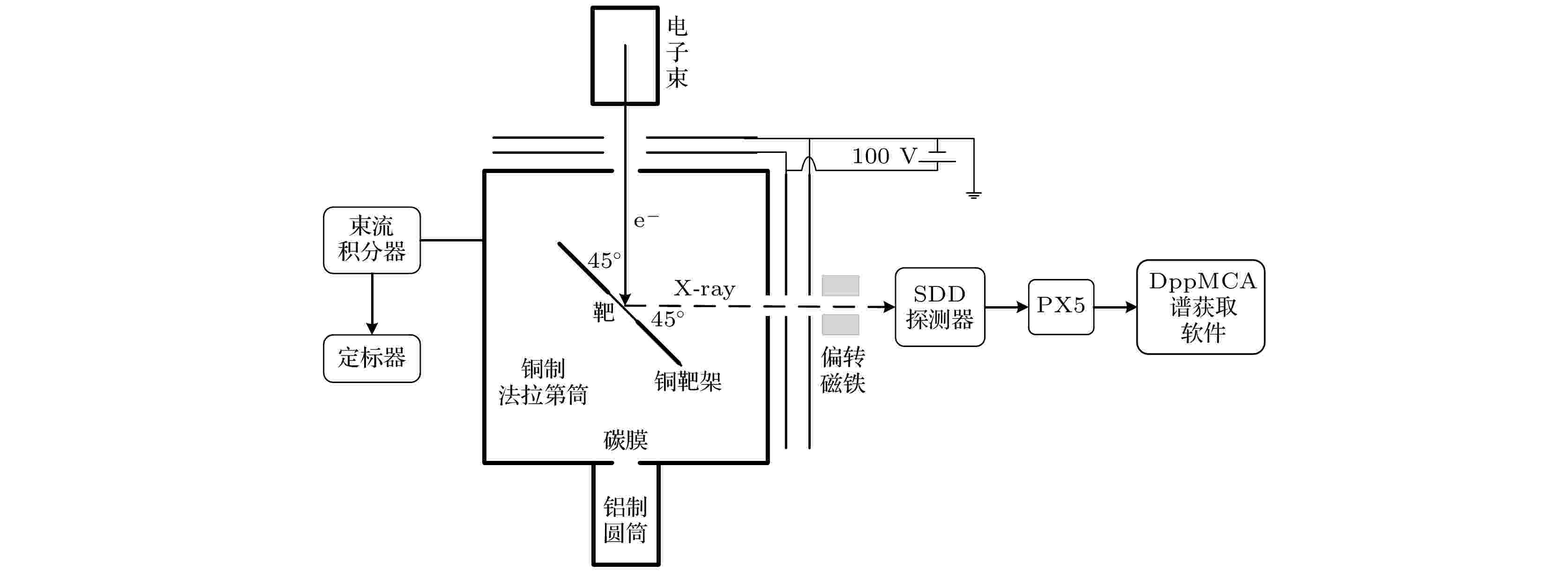
2022, 71 (17): 173402.
doi:10.7498/aps.71.20220162
Abstract +
The K-shell ionization cross sections of Al, Ti, Cu and L-shell characteristic X-ray production cross sections of Cu, Ag and Au (Lα, Lβ and Lγ subshells for Au) by electron impact at incident energy of 5–27 keV are determined experimentally. Thin films of the studied elements, deposited on thin carbon substrates, are employed as targets in the experiments. The thickness of the thin carbon substrate is 7 μg/cm2, the targets are Al, Ti, Cu, Ag and Au and their thickness values are 5.5 μg/cm2, 28 μg/cm2, Cu 35.5 μg/cm2, 44 μg/cm2and 44 μg/cm2, respectively. The target thickness values are checked by using Rutherford Backscattering Spectrometry (RBS). The electron beam is provided by a scanning electron microscope (KYKY-2800B). The characteristic X-rays produced are recorded by a silicon drifted detector (XR-100SDD, Amptek), which has a C2 ultrathin window and can detect the low-energy X-rays down to boron Kα line (0.183 keV). The detector efficiency is calibrated by using the standard sources (55Fe,57Co,137Cs and241Am) for X-ray energy larger than 3.3 keV while using the characteristic peak method (i.e. by measuring characteristic X-ray spectra produced by 20 keV electron impacting various thick solid targets) for X-ray energy less than 3.3 keV. The experimental results are corrected by the Monte Carlo code PENELOPE for the effects of target structure and Faraday cup. Meanwhile, the electron escape rates obtained from the Faraday cup and the signal pile-up effect are also considered. The results show that when the incident electron energy is low, the influences of electron energy loss and target thickness are significant. The thinner the target , the smaller the correction is. Experimental uncertainties for K-shell ionization cross sections of Al, Ti and Cu are about 5.0%, 5.6% and 5.1%, respectively; experimental uncertainties for L-shell X-ray production cross sections for Cu and Ag are about 5.3% and 4.0%, and for Lα,Lβ,and Lγ of Au are about 6.1%, 8.9% and 11.0%, respectively. The experimental L-shell characteristic X-ray production cross sections of Cu are given for the first time. Compared with the theoretical values of the semi-relativistic distorted-wave Born approximation (DWBA), most of the experimental values in this work are in good agreement within 7% deviation. The best agreement between the experimental results and the theoretical values is obtained for the K shell ionization cross section of Al, and the deviation is less than 1.7% for the data where the incident energy is above 10 keV. The least consistency with the theoretical values is the experimental L shell characteristic X-ray production cross sections of Cu, with a deviation being about 5–22%. The comparison of the experimental L shell characteristic X-ray production cross sections of Cu (including Ga and As elements) with those from the DWBA theory indicates that the theoretical calculations of L shell ionization cross sections of medium heavy elements and the corresponding atomic parameters (such as fluorescence yields and Coster-Kronig transition probabilities) need to be more accurately determined. According to the present results, the ionization cross sections or characteristic X-ray production cross sections measured by the thin target thin substrate, the thin target thick substrate and the thick target methods are equivalent to each other within the uncertainties.
ELECTROMAGNETISM, OPTICS, ACOUSTICS, HEAT TRANSFER, CLASSICAL MECHANICS, AND FLUID DYNAMICS
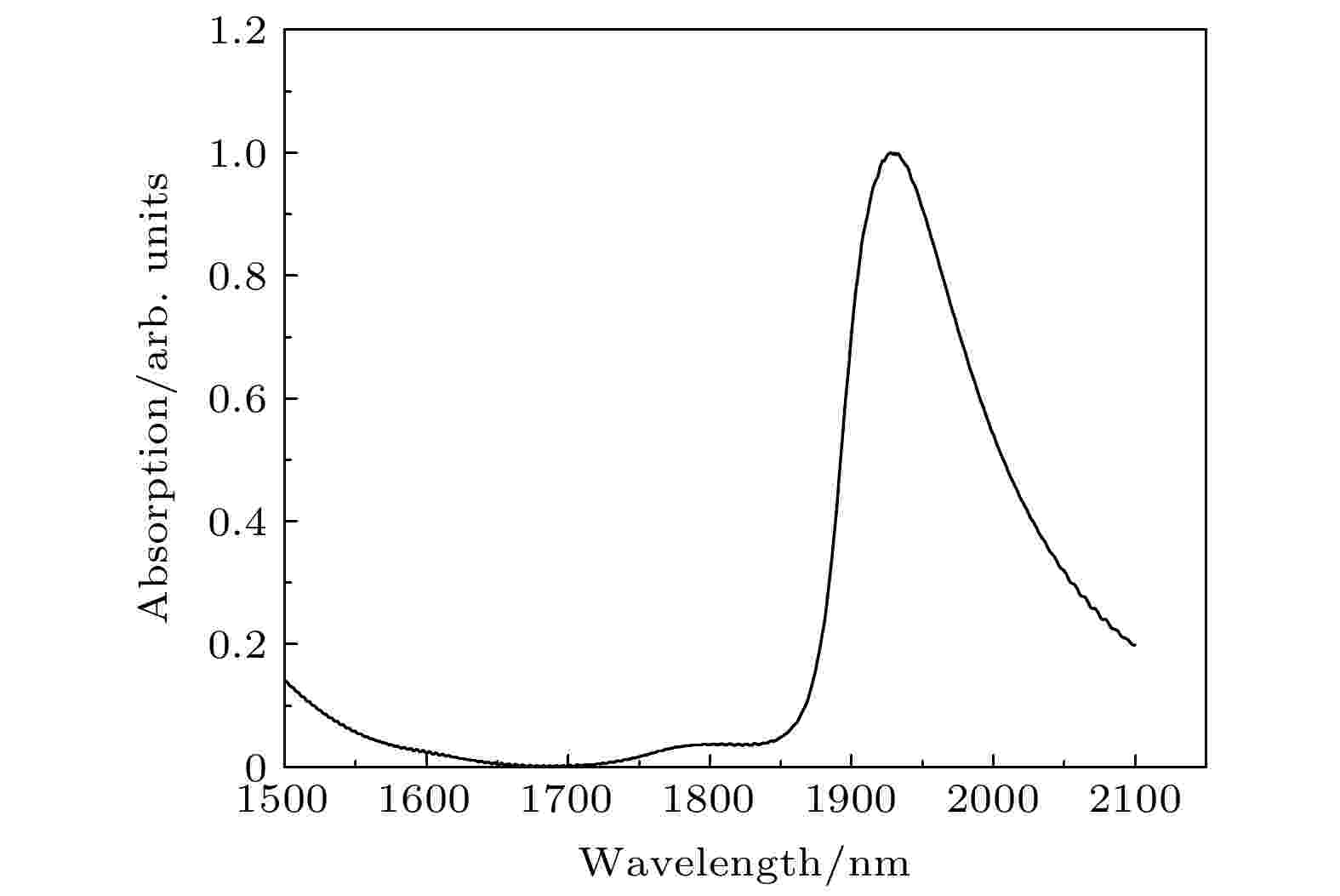
EDITOR'S SUGGESTION
2022, 71 (17): 174202.
doi:10.7498/aps.71.20212125
Abstract +
All-fiber laser with short pulses possesses many advantages, such as superior stability, compact structure, and high single pulse energy. Recently, short pulse laser working in a 1.8–2.0 μm spectral region has received considerable attention due to its wide applications in laser spectroscopy, biomedicine, optical communications and sensing. The passiveQ-switched and mode-locked operations by saturable absorber (SA) have been considered to be convenient and low-cost ways to achieve short pulses. Recently, pure water has been reported as the ideal SA because of its advantages of high damage threshold, low prices, good thermal diffusivity and stability. In this work, Tm-doped all-fiber pulse laser based on pure water as the SA is demonstrated. The pure water is fixed between two FC/PC fiber patchcord by the ceramic cannula, so we can change the loss of SA easily. TheQ-switched and mode-locked operations can be obtained by adjusting the water layer thickness. The maximum output power atQ-switched state is 0.531 mW, the repetition frequency is 53.45 kHz, and the pulse width is 3.01 μs. The maximum output power at mode-locked state is 2.28 mW, the repetition rate is 17.69 MHz, and the pulse width is 1.42 ps. To our knowledge, this is the first passive mode-locked fiber laser using pure water as a saturable absorber, and provides a new scheme for thulium-doped all-fiber pulse lasers.
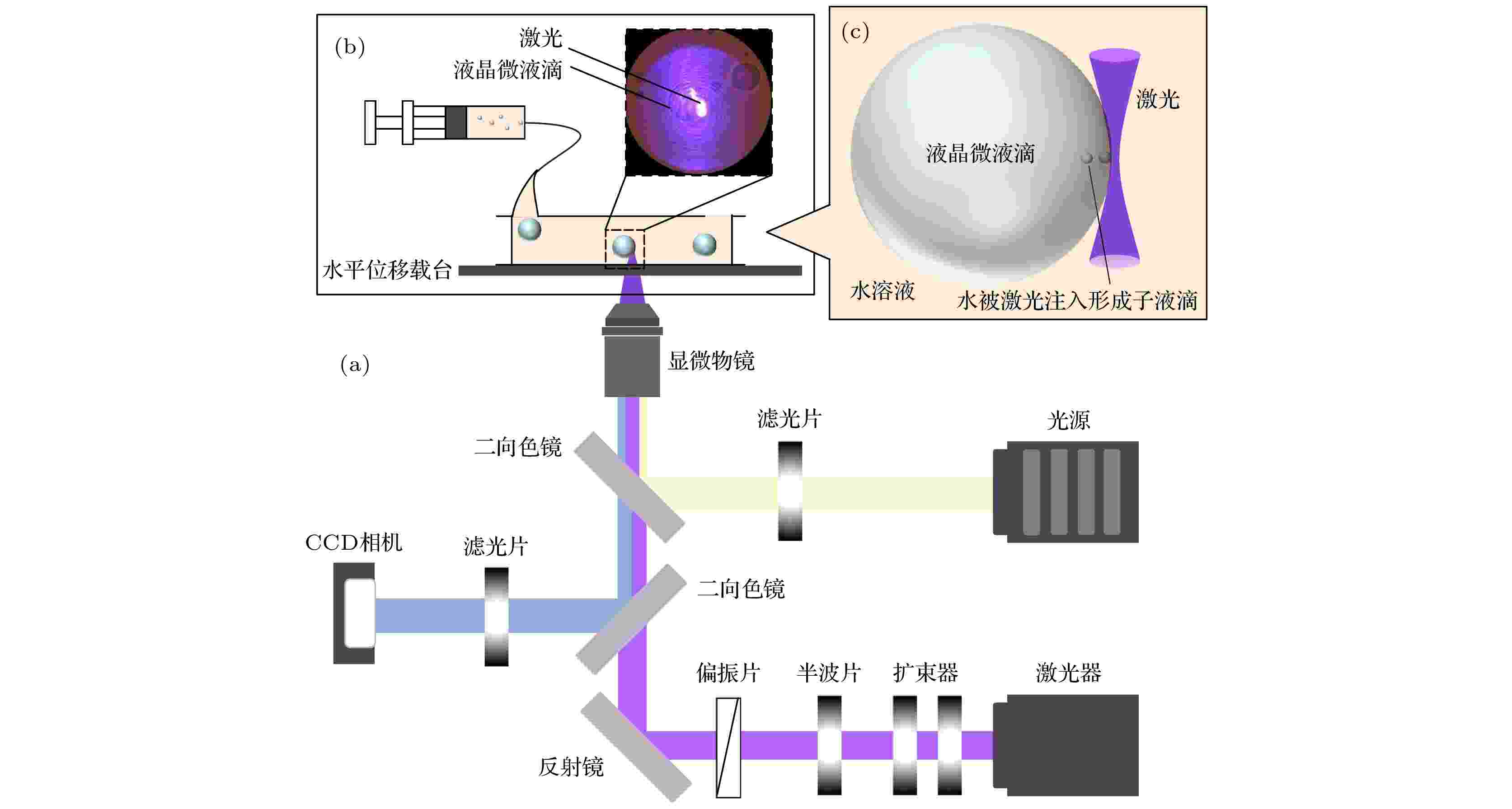
2022, 71 (17): 174203.
doi:10.7498/aps.71.20220625
Abstract +
Laser micro/nanomachining technology for soft matter achieves the purpose of fabricating the spherical structures of soft matter by combing laser-assisted mechanical injection and controllable self-assembly, which has significant advantages in comparison with conventional methods like droplet microfluidics. In this study, the effects of laser parameters such as laser energy, beam size, and irradiation position on the injection are investigated. It is found that there also exists one upper limit of the laser energy, and if the laser irradiation is too strong, it can introduce a convection flow of liquid crystal rather than trigger off the injection of guest microdroplets. Thus, the laser injection can be achieved in a specific energy range of the laser irradiation. By manipulating the laser beam with a smaller size, the guest water microdroplets can be injected at the preselected location on the surface of a host liquid crystal droplet. In addition, the influences of material parameters such as the surfactant concentration, the material type and phase state of liquid crystal on the laser-assisted mechanical injection, and the size of the injected guest droplet are investigated. It is found that the liquid crystal droplet with higher surfactant concentration requires less energy from the laser irradiation to generate enough mechanical force to trigger off the injection. Because under the same temperature increment, the liquid crystal droplet with higher ion concentration enjoys a stronger surface tension gradient. By comparing several different types of liquid crystals, it is found the injection of guest droplets into a host with a higher elastic constant liquid crystal can be more difficult. The influences of the material type of liquid crystal and the concentration of surfactant on the critical size of guest microdroplets are summarized. Finally, the defect lines of liquid crystal are introduced as the self-assembly template, through which microdroplets of liquid crystal with the sophisticated spherical structure are fabricated. The self-assembly kinetic behaviors of guest droplets in the defect line are analyzed. The laser micro/nanomachining technology of soft matter can be applied to the extreme processing and application development of 3D spherical structures in the fields of optoelectronics, photonics, and biomedicine.
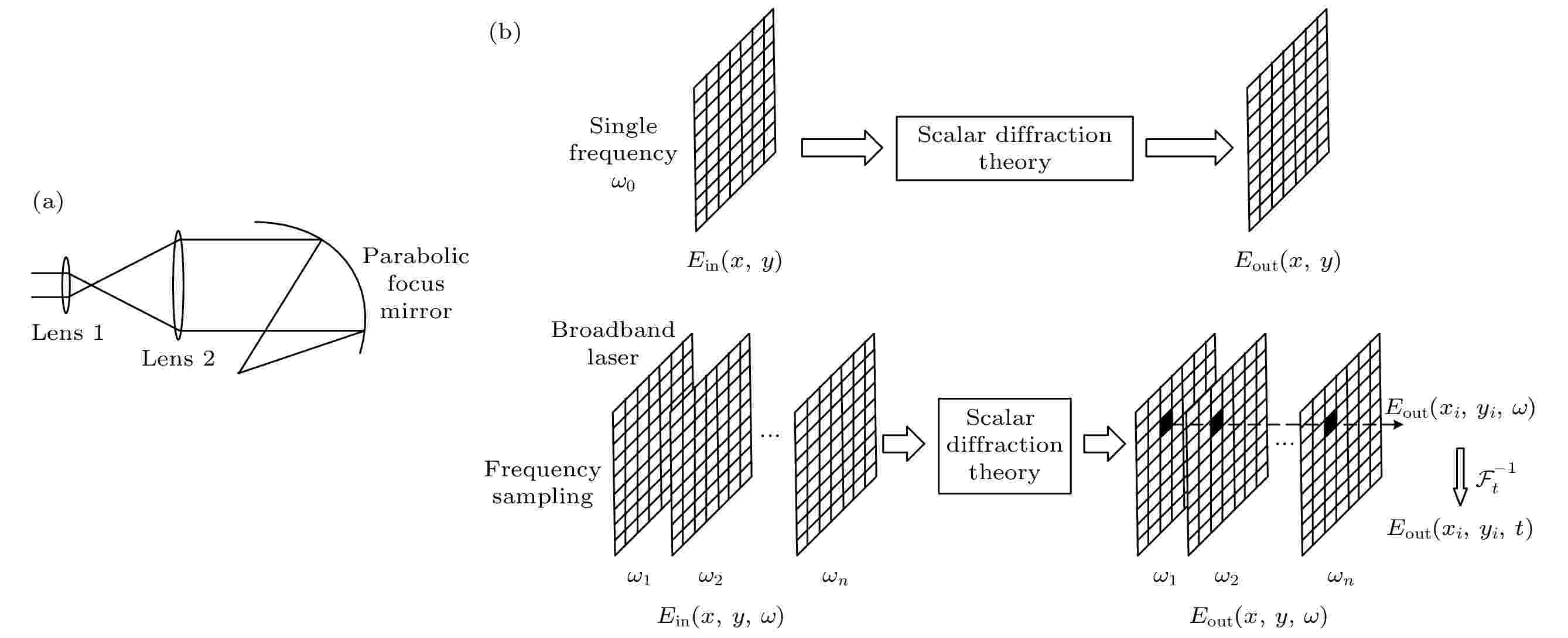
2022, 71 (17): 174204.
doi:10.7498/aps.71.20220563
Abstract +
In a large-scale ultra-fast and ultra-intensity laser system, with the increase of spectral bandwidth and beam aperture, the spatiotemporal coupling distortion will become more and more significant. This effect will not only degrade the beam quality and reduce the focusing intensity of the laser, but also invalidate the conventional evaluation method for laser far-field parameters. A pair of beam-expanding lenses, which may bring spatiotemporal coupling distortion to an ultrashort laser pulse, is taken as an example. And the influence of spatiotemporal coupling distortion on laser parameter measurement is analyzed in detail. It shows that in an ultrashort pulse laser system, an ordinary beam-expanding lens-pair can reduce the far-field peak intensity dramatically, and the actual pulse duration in the far field is more than 10 times longer than that measured at the near field by a single-shot autocorrelator. In this case, the focusing intensity estimated by using the measured value of near-field pulse width will be one order of magnitude bigger than the real value. It is expected that the results will be helpful in the optimal design of a laser system, the accurate characterization of an ultrafast laser pulse and relevant physical experiments.
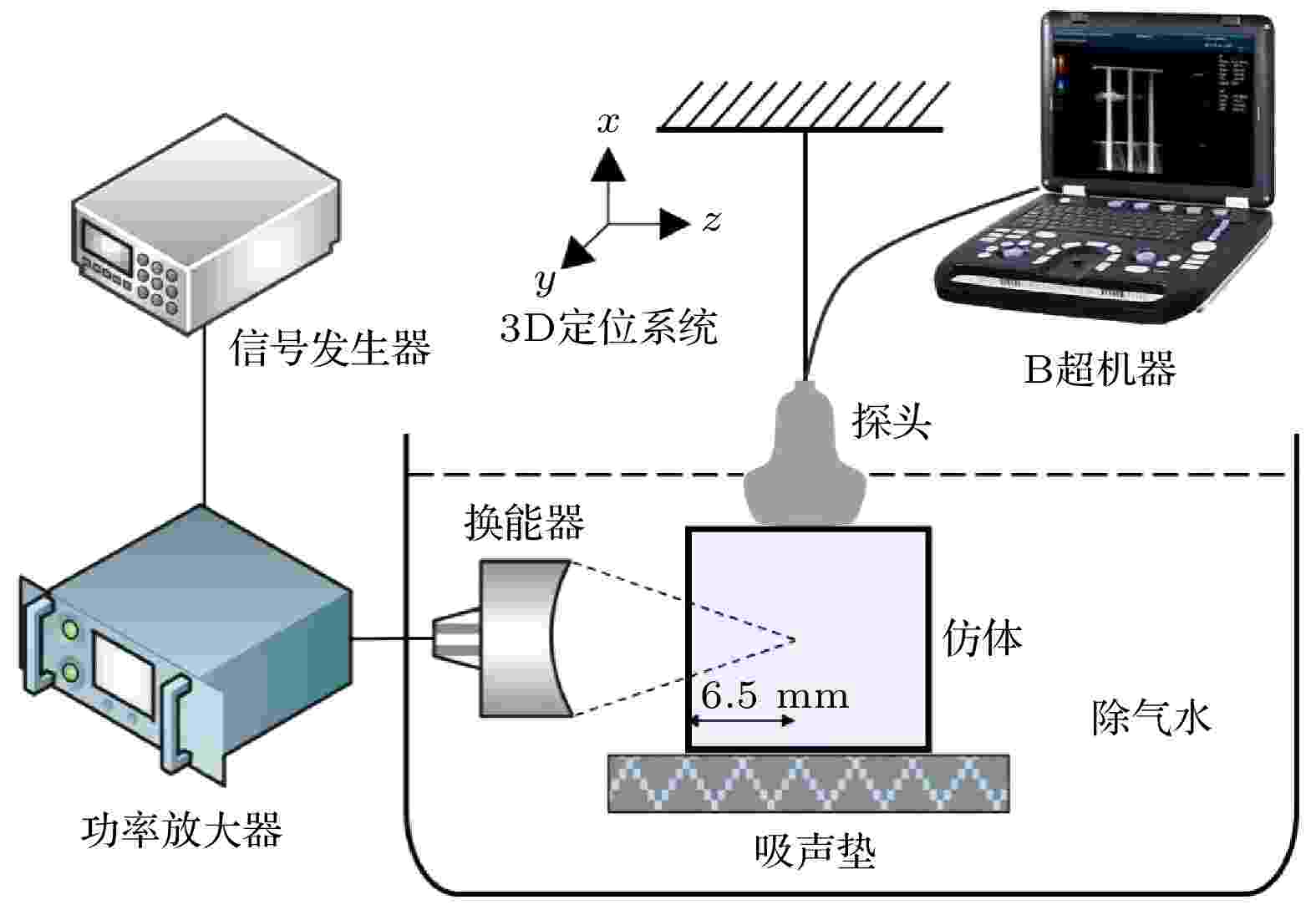
EDITOR'S SUGGESTION
2022, 71 (17): 174301.
doi:10.7498/aps.71.20220558
Abstract +
The violent inertial cavitation effect generated during high intensity focused ultrasound (HIFU) treatment may damage healthy tissues around the target area. Therefore, it is urgent to develop new technical approaches that can quantitatively monitor the acoustic cavitation motions in biological tissues with high precision in space and time, so as to ensure clinical safety and effectiveness. Compared with the traditional commercial ultrasonic gray value signal, the ultrasonic radio frequency (RF) signal can well retain more detailed information about the acoustic scattering signal. As a statistical parameter not based on mathematical function model, the information entropy can characterize the spatiotemporal evolution state of disorder of scatters inside tissues resulting from acoustic cavitation. Therefore, this paper proposes a real-time monitoring system for spatiotemporal evolution of acoustic cavitation based on the entropy analysis of ultrasonic RF signals. First, the original RF signal of scattered echoes generated by HIFU-induced cavitation bubbles inside the gel phantom is obtained by using a modified B-ultrasound system, and the two-dimensional mean filtering method is used to suppress the HIFU-induced strong interferences overlapping with cavitation monitoring imaging signals. Then, the dynamic variation range of the RF signal is expanded through data standardization processing, and the entropy image is reconstructed based on the sliding window information entropy analysis to demonstrate the spatiotemporal evolution status of the HIFU-induced cavitation behanviors. The experimental results indicate that the acoustic cavitation imaging algorithm based on RF signal entropy analysis should be more sensitive and accurate than the B-model gray scale imaging method for determining the onset time and spatial position of cavitation activities, which is helpful in ensuring the safety and efficacy of HIFU clinical treatment. Thepresent work will provide a useful tool for the spatiotemporal monitoring of the acoustic cavitation generated in tissues during HIFU treatment, and lays a solid theoretical and experimental foundation to establish an effective quantity-effect evaluation system for the cavitation related biological effect.

EDITOR'S SUGGESTION
2022, 71 (17): 174302.
doi:10.7498/aps.71.20220629
Abstract +
Function of spinal cord is crucial to nerve conduction pathway. Traumatic spinal cord injury often results in a vasculature disruption after primary insult and further leads to abnormal responses of the intact vessels in neighboring tissue during secondary injury. Therefore, the vasculature and blood supply play significant roles in evaluating the spinal cord function . Ultrasound localization microscopy (ULM) overcomes the shortcomings of extensively used angiography, such as computed tomography angiography (CTA) and magnetic resonance angiography (MRA), in terms of limited resolution, radiation and poor-portability, which meets the needs of comprehensive intraoperative examination and prognosis tracking. In this study, an L22-14vX probe with a transmission frequency of 15.625 MHz is utilized, yielding an imaging wavelength of 100 μm. The ULM is conducted based on ultrafast ultrasound technology with multiple tilted plane-wave illuminations. Robust principal component analysis (RPCA) based spatial-temporal clutter filtering method is used for separating the microbubble signals from tissue signals and high frequency noise. Through microbubble localization, trajectory tracking and mapping, subwavelength super-resolution ultrasound imaging is finally achieved. The whole process of microbubble localization and vessel reconstruction are monitored through measuring the time dependent microbubble detections and saturation. Saturation curve corresponds to the time dependent total area covered by microbubble detections on the image. Quantification analysis is carried out for evaluating the imaging results including resolution measurements based on the Fourier ring correlation (FRC) and full-width at half-maximum (FWHM). Thein-vivoexperimental results show that ULM can be used to obtain super-resolution vasculature imaging in rat spinal cord. The velocity distributed from 1 mm/s to 50 mm/s can be detected. Within the same vessel, the velocity of a point is inversely correlated with the distance from the point to the center of the vessel. The velocity in the center of the vessel is larger than that at the wall of the vessel. The larger vessels support higher flow in the center of the vessel. The FWHM results indicate that ultrafast Doppler displays vessels in diameters between 135 μm and 270 μm while ULM displays them in diameters between 28 μm and 35 μm. The FRC-based resolution evaluation shows that the ULM achieves a super resolution of 16 μm, much less than the imaging wavelength of 100 μm. Yet, long acquisition time is required to detect microbubbles in the smallest vessels, leading to long reconstruction of the microvasculature, which is still a problem worth studying . Compromise between saturation and acquisition time needs considering. Generally speaking, microbubbles are more likely to flow in large vessels, leading to relatively short reconstruction time of large vessels. When saturation curve almost converges, the imaging improvement with new vessels is not so significant that the detail sacrifice of some small microvessels can reduce acquisition time (i.e. most of microvasculature can still be gained when the saturation curve does not converge). Besides, the increase of microbubble concentration and advanced track identification and extraction may also accelerate the saturation rate of convergence with acquisition time decreasing. In conclusion, ULM can be used to obtain a super-resolution imaging of spinal cord microvasculature, giving a 10-fold improvement in resolution in comparison with ultrafast Doppler imaging. Relevant results can facilitate the super-resolution ULM imaging of spinal cord which may promote the function diagnosis, treatment intervention, disability prevention, and prognosis recovery of spinal cord injury.

2022, 71 (17): 174701.
doi:10.7498/aps.71.20220411
Abstract +
Internal solitary waves exist widely in the oceans, and their generations, propagation evolutions, and dissipations have profound effects on the ocean environment, topography, and marine structures. Typically, two basic theoretical models are now being developed to govern the evolutions of internal solitary waves at the interface of two immiscible inviscid fluids. One is a unidirectional wave propagation model described by the KdV (Korteweg-de Vries) equation, and the other is a bidirectional wave propagation model depicted by the Miyata-Choi-Camassa (MCC) equation. Neither of them, however, can effectively characterize the course of the evolution of large-amplitude internal solitary wave. In this paper, a modified unidirectional internal solitary wave model is established by adjusting the coefficients of the original unidirectional model. The adjusted coefficients are determined through asymptotic analysis by matching with the MCC model. The efficacy of the modified coefficients is investigated by comparing the modified model with the original model. The experiments on the generation of internal solitary waves with varying amplitudes are carried out by comparing the internal solitary wave solution of the modified equation. It is shown that the modified model is suitable for describing the waveform of internal solitary waves with small, medium, and large amplitudes within the limiting amplitude of the MCC model. By quantitatively analyzing the agreement of the effective wavelength, wave speed, and waveform of steady-state internal solitary waves between the unidirectional model and the MCC model, the applicability of the modified model in characterization of the properties of steady-state internal solitary waves is further investigated. In addition, the stability of unidirectional theoretical model is analyzed for simulating the propagation of large-amplitude internal solitary wave under flat bottom condition. It is found that the unidirectional model is suitable for initiating its own internal solitary solution provided that the numerical scheme is stable. It is shown that the modified unidirectional model can be used to characterize large-amplitude internal solitary waves, and is also expected to be applied to the study of marine structure hydrodynamics.
PHYSICS OF GASES, PLASMAS, AND ELECTRIC DISCHARGES
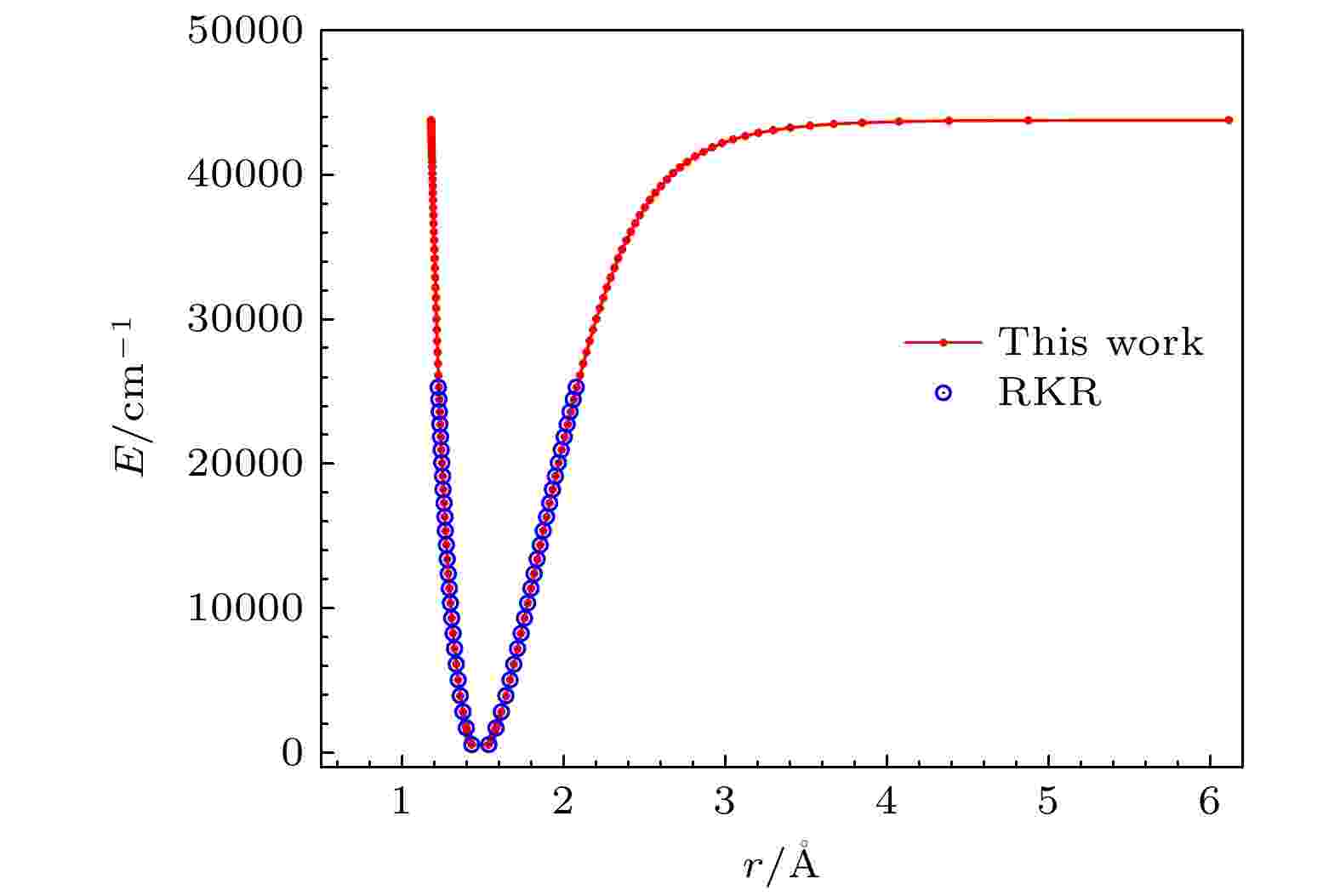
2022, 71 (17): 175101.
doi:10.7498/aps.71.20212273
Abstract +

2022, 71 (17): 175201.
doi:10.7498/aps.71.20212255
Abstract +
The (3 + 1) dimensional nonlinear ion acoustic waves in multicomponent complex plasma with Kappa electron distribution are studied in this work. The Zakharov-Kuznetsov (ZK) equation for ion acoustic wave is investigated by the reductive perturbation method. The variation of nonlinear ion acoustic wave with system parameter is obtained. Meanwhile, the Sagdeev potential function is obtained by using the Sagdeev potential method. And the phase diagram in a two-dimensional autonomous system of the multicomponent complex plasma with Kappa electron distribution is studied. Finally, the important influence of system parameter on the phase diagram, the Sagdeev potential function and the propagating characteristics of (3 + 1) dimensional nonlinear acoustic solitary waves are discussed in detail.
CONDENSED MATTER: STRUCTURAL, MECHANICAL, AND THERMAL PROPERTIES
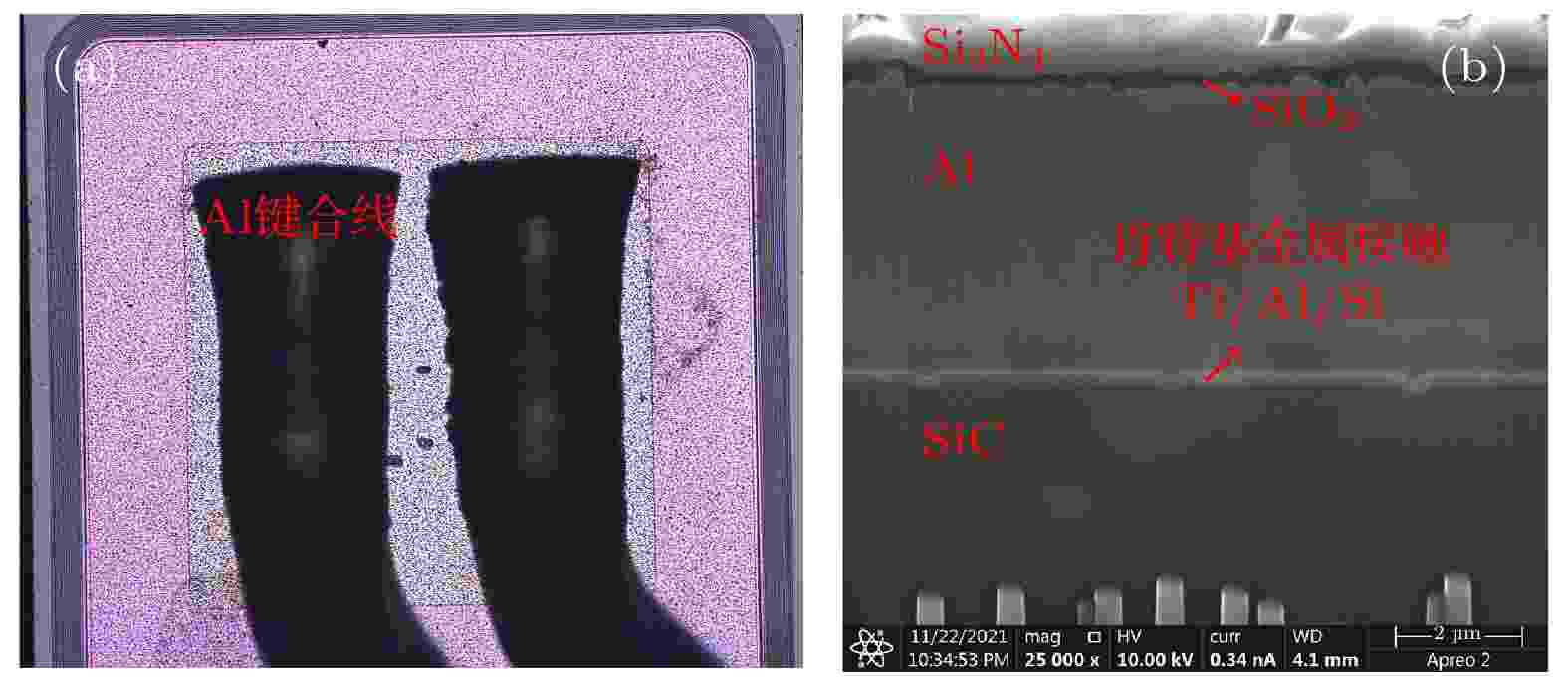
2022, 71 (17): 176101.
doi:10.7498/aps.71.20220628
Abstract +
In this paper, the failure mode and mechanism of silicon carbide (SiC) Schottky barrier diode (SBD) irradiated by high-energy tantalum (Ta) ions are studied. The experimental results show that the reverse bias voltage during irradiation is the key factor causing the failure of SiC SBDs. When the reverse bias of the device is 400 V, the heavy ions will cause the single event burnout (SEB), and a “hole” formed by the melting of SiC material appears in the irradiated device. When the reverse bias is 250–300 V, the failure is manifested as the off state leakage current increases with the ion fluence. The higher the bias voltage of the device, the higher the leakage increase rate caused by heavy ions. For the devices with increased leakage, the leakage channels caused by heavy ions are found in the whole active region, based on microscopic analysis. The TCAD simulation results show that the incidence of heavy ions will lead the lattice temperature to increase in the device, and the maximum lattice temperature increases with bias voltage increasing. When the bias voltage is large enough, the local lattice temperature inside the device reaches the melting point of SiC material, resulting in SEB. When the bias voltage is relatively low, the lattice temperature is lower than the melting point of SiC material, so it will not cause burnout. However, the maximum lattice temperature in the device is concentrated near the Schottky junction, and the melting point of Schottky metal is much lower than that of SiC material. This may lead the Schottky junction to damage locally and eventually produce leakage path.
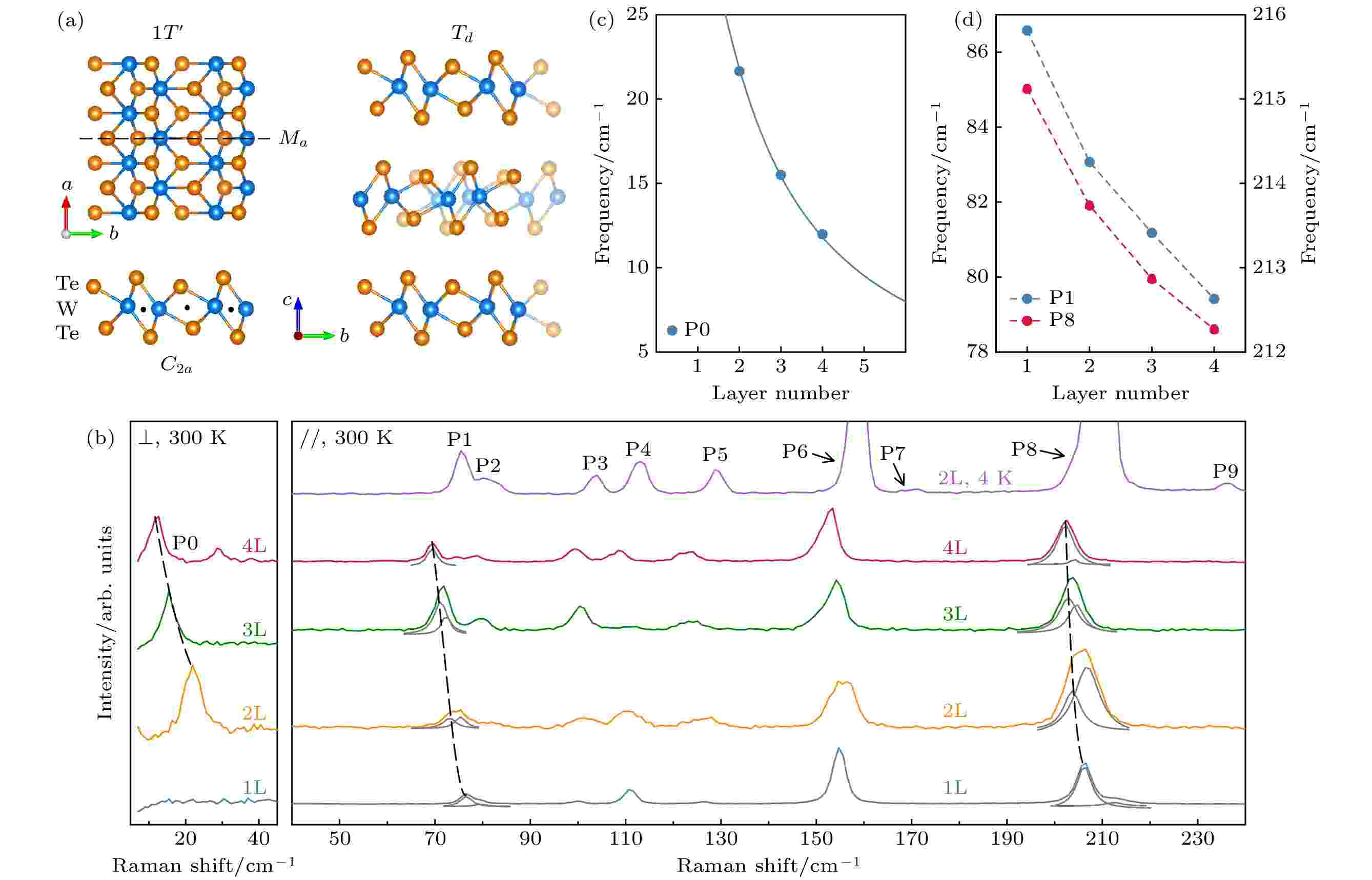
EDITOR'S SUGGESTION
2022, 71 (17): 176301.
doi:10.7498/aps.71.20220804
Abstract +
Two-dimensional WTe2possesses a special crystal symmetry, leading to novel properties such as quantum spin Hall effect and nonlinear Hall effect. Determining the details of its crystal structure is essential for understanding these interesting properties. Here, we report an optical study on the crystal symmetry of monolayer, bilayer, and trilayer WTe2, using temperature and polarization dependent Raman spectroscopy and optical second harmonic generation (SHG). We find that monolayer WTe2is noncentrosymmetric as indicated by its sizable SHG, in contrast to the commonly believed centrosymmetric 1T'structure. The polarization dependence of the SHG is consistent with theCspoint group. Bilayer WTe2exhibits SHG signal more than one order of magnitude higher than in the monolayer and trilayer samples, with its temperature dependence reflecting the ferroelectric phase transition, evidencing strong inversion symmetry breaking induced by layer stacking and interlayer-sliding ferroelectricity. We also observe prominent second-order resonant Raman scattering peaks only in monolayer and bilayer WTe2, but not in thicker samples, and their temperature dependence indicates an electronic structure highly sensitive to interlayer coupling. These results will be useful for further exploring the properties of atomically thin WTe2.
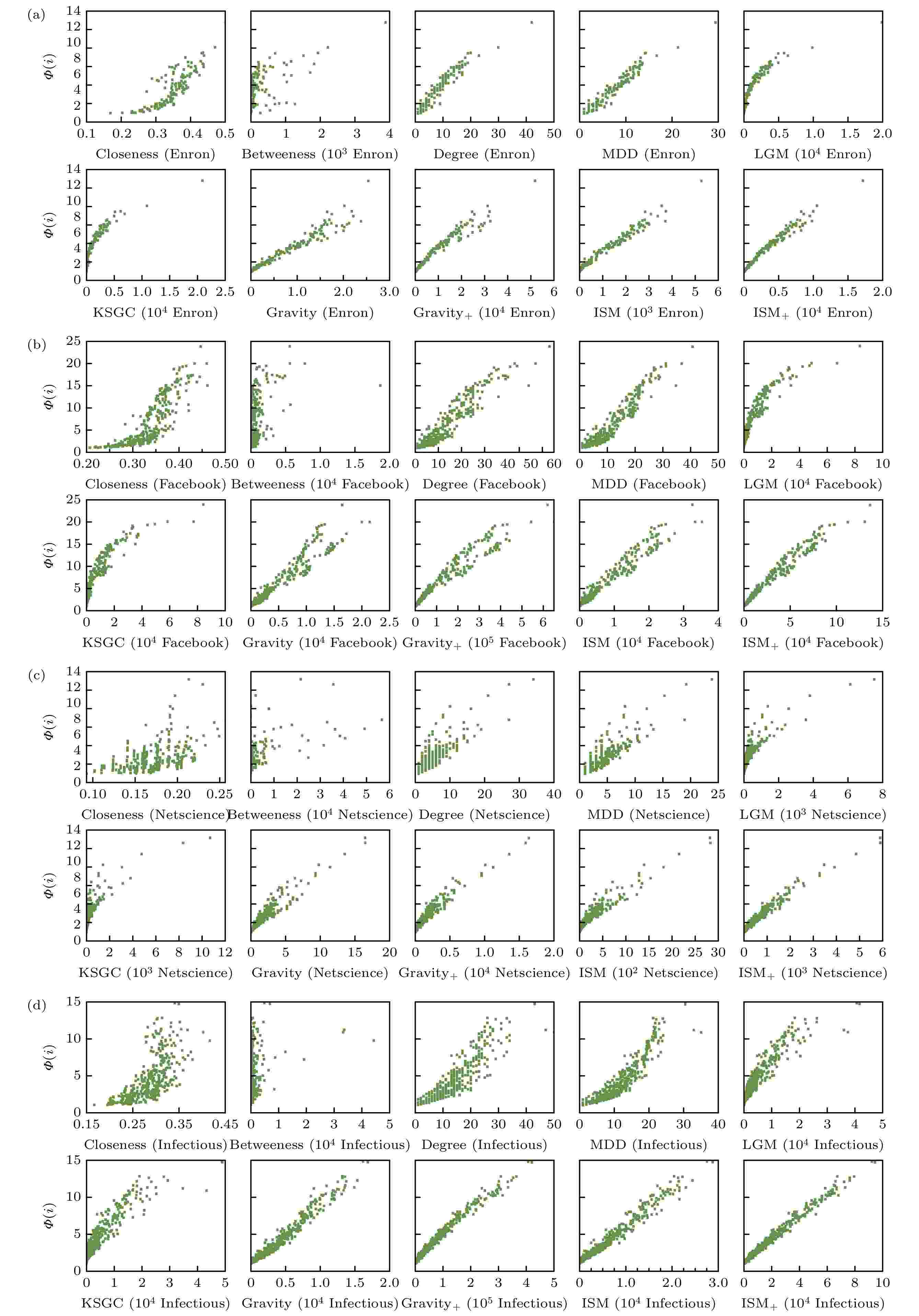
2022, 71 (17): 176401.
doi:10.7498/aps.71.20220565
Abstract +
How to use quantitative analysis methods to identify which nodes are the most important in complex network, or to evaluate the importance of a node relative to one or more other nodes, is one of the hot issues in network science research. Now, a variety of effective models have been proposed to identify important nodes in complex network. Among them, the gravity model regards the coreness of nodes as the mass of object, the shortest distance between nodes as the distance between objects, and comprehensively considers the local information of nodes and path information to identify influential nodes. However, only the coreness is used to represente the quality of the object, and the factors considered are relatively simple. At the same time, some studies have shown that the network can easily identify the core-like group nodes with locally and highly clustering characteristics as core nodes when performingk-core decomposition, which leads to the inaccuracy of the gravity algorithm. Based on the universal gravitation method, considering the nodeHindex, the number of node cores and the location of node structural holes, this paper proposes an improved algorithm ISM and its extended algorithm ISM+. The SIR model is used to simulate the propagation process in several classical real networks and artificial networks, and the results show that the proposed algorithm can better identify important nodes in the network than other centrality indicators.
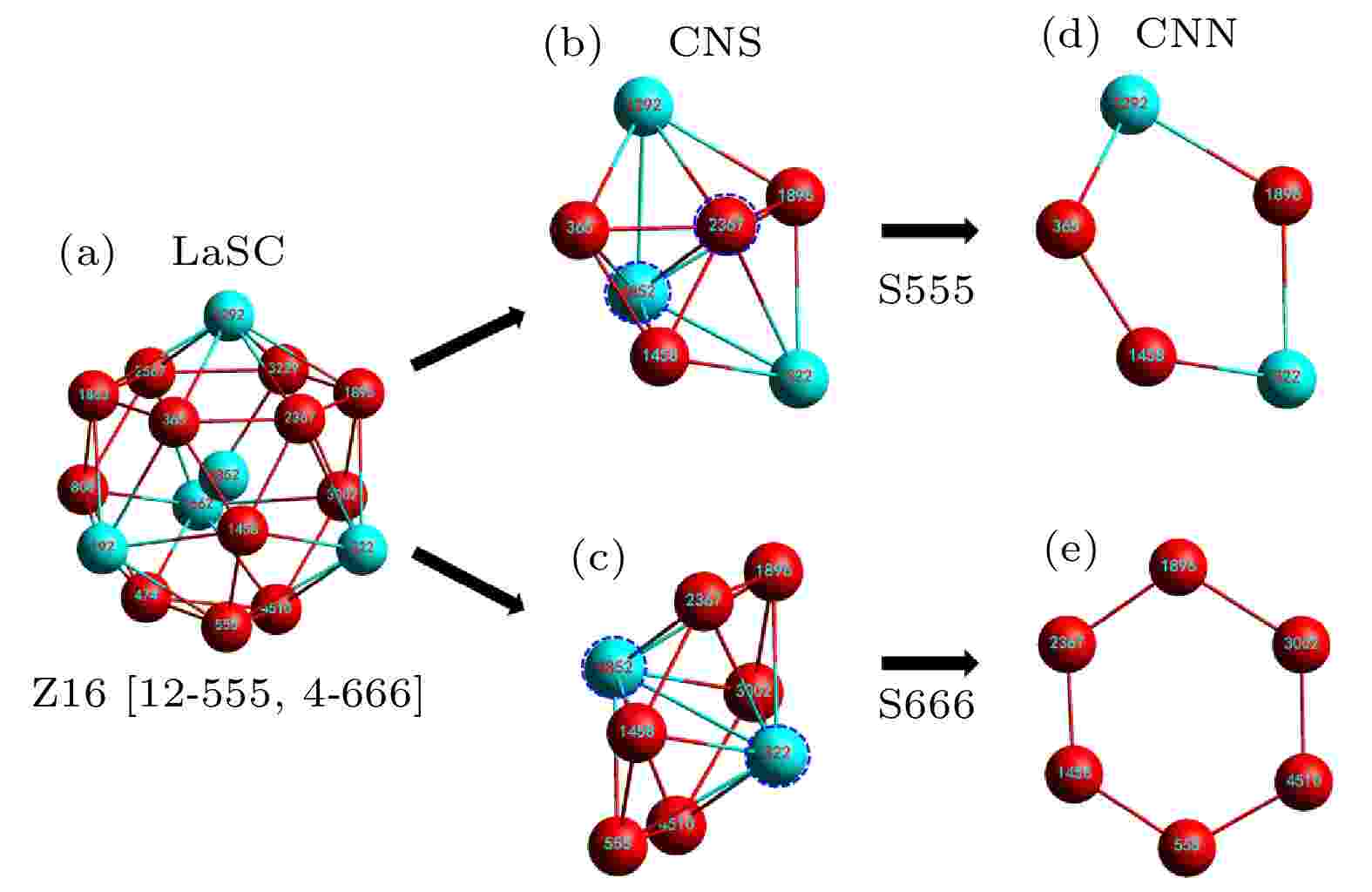
2022, 71 (17): 176402.
doi:10.7498/aps.71.20220662
Abstract +
Simulation has become an important tool in materials science, it is a prerequisite to study the correlation between the structure and properties of materials, in that the structural characteristics of the system from the atomic coordinates output can be obtained by simulations. For simple (FCC, HCP, and BCC) crystals containing only 2-6 atoms, in the numerical analysis method, what needs to be determined is only the local characteristics of each atom. However, it is extremely computationally intensive to determine the cells containing tens or hundreds of atoms. The combination of numerical analysis and visualization is one of the methods to solve this kind of problem. In this work, Ni70Ag30nanoparticles are simulated by molecular dynamics. It is found that the nanoparticles contain FCC crystals and a large number of complex topologically close-packed (TCP) structures. Using the analysis software based on the largest standard cluster analysis (LaSCA), the C15 phase of TCP atoms in nanoparticles is determined by topology configuration analysis and crystallography knowledge. The analytical ideas provide the algorithm logic fordeveloping the numerical recognition software for complex crystal structures in the future.
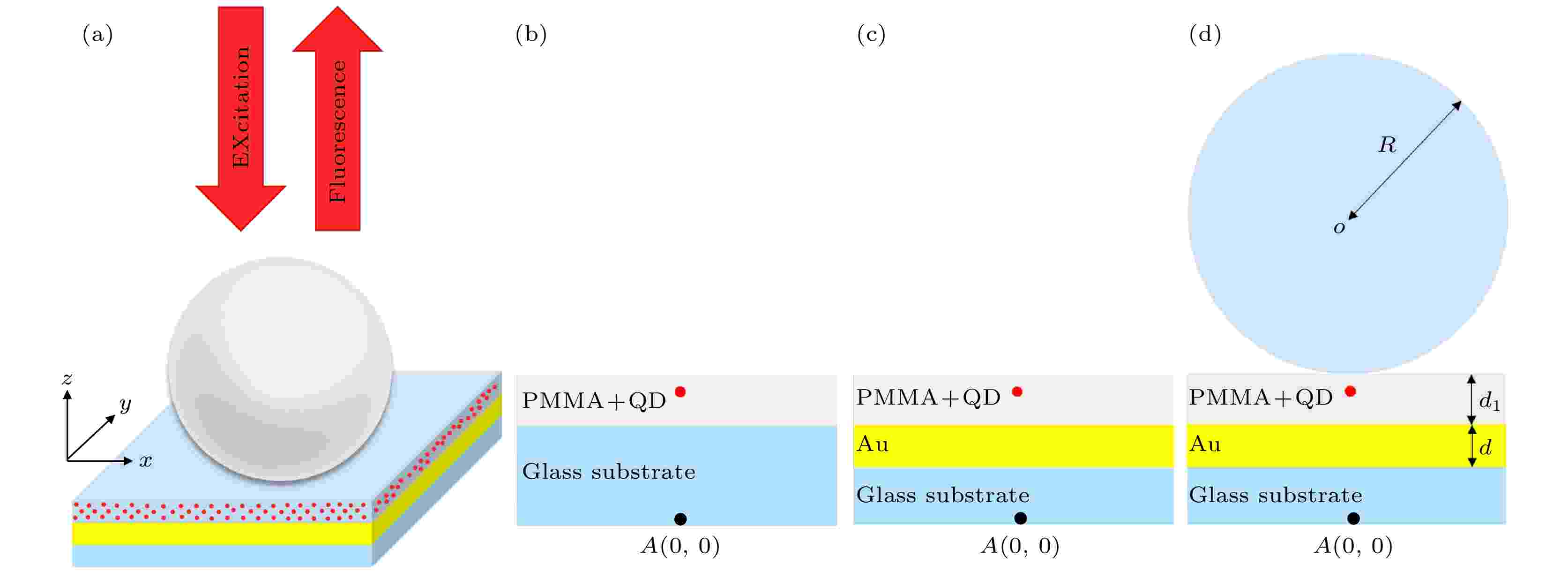
2022, 71 (17): 176801.
doi:10.7498/aps.71.20220605
Abstract +
Controlling the emission characteristics of fluorescent substances and increasing the intensity of fluorescence emission are crucial for fluorescence detecting technology in single-molecule detection, biomedicine, and sensing applications. Since fluorescence emission is isotropic in nature, the collected fluorescence is only accounted for a small fraction of the total emitted fluorescence. In this paper, a composite structure composed of dielectric microsphere and metallic planar nanolayers is proposed to enhance the fluorescence far-field directional emission intensity and improve the fluorescence collection efficiency. The excitation process and the emission process of quantum dots (QDs) located between the dielectric microspheres and the gold layer are investigated by the finite difference time domain (FDTD) method. In the emission process, the emission of QDs in a homogeneous medium is isotropic. Therefore, we usually select several special polarizations in theoretical analysis state for research. In this paper, we first study the effect of the structure on the fluorescence emission enhancement of QDs when the QDs are in thex-,y-, andz-polarization state. Some results can be obtained as shown below. When the radiation direction of the QDs is perpendicular to the microsphere plane layered structure, the structure is coupled with the emitted fluorescence, thereby realizing the directional enhancement of the emitted fluorescence of the QDs, and the obvious fluorescence enhancement is obtained in thex-andy-polarization state. Therefore, in the research, we choose and investigate the dipole light source ofx-polarization state. We mainly study the influence of microsphere radius, refractive index, and QDs position on the fluorescence directional enhancement. The QDs as a fluorescent material are coated in polymethyl methacrylate (PMMA) to control the distance from the gold layer to tune the fluorescence enhancement. The structure is based on the synergistic effect among plasmon coupling, whispering gallery mode and photonic nanojet, which enhances the far-field fluorescence of QDs by a factor of 230, and the fluorescence collection efficiency is as high as 70%. Comparing with the enhanced fluorescence of the dielectric microspheres and the gold sphere dimer composite structure, the distance between the gold sphere dimers is not easy to control, and the QDs should be placed at specific positions between the gold spheres. The structure we propose is more convenient to implement. In this paper, not only the emission enhancement process of QDs is studied in detail, but also the excitation process of QDs is investigated. Our proposed dielectric microsphere metal planar nanolayered structure can enhance the excitation of QDs in most areas, proving that our designed structure can effectively realize the excitation enhancement of QDs. The above results have very important applications in the fluorescence biological detection, imaging, and light-emitting devices.
CONDENSED MATTER: ELECTRONIC STRUCTURE, ELECTRICAL, MAGNETIC, AND OPTICAL PROPERTIES
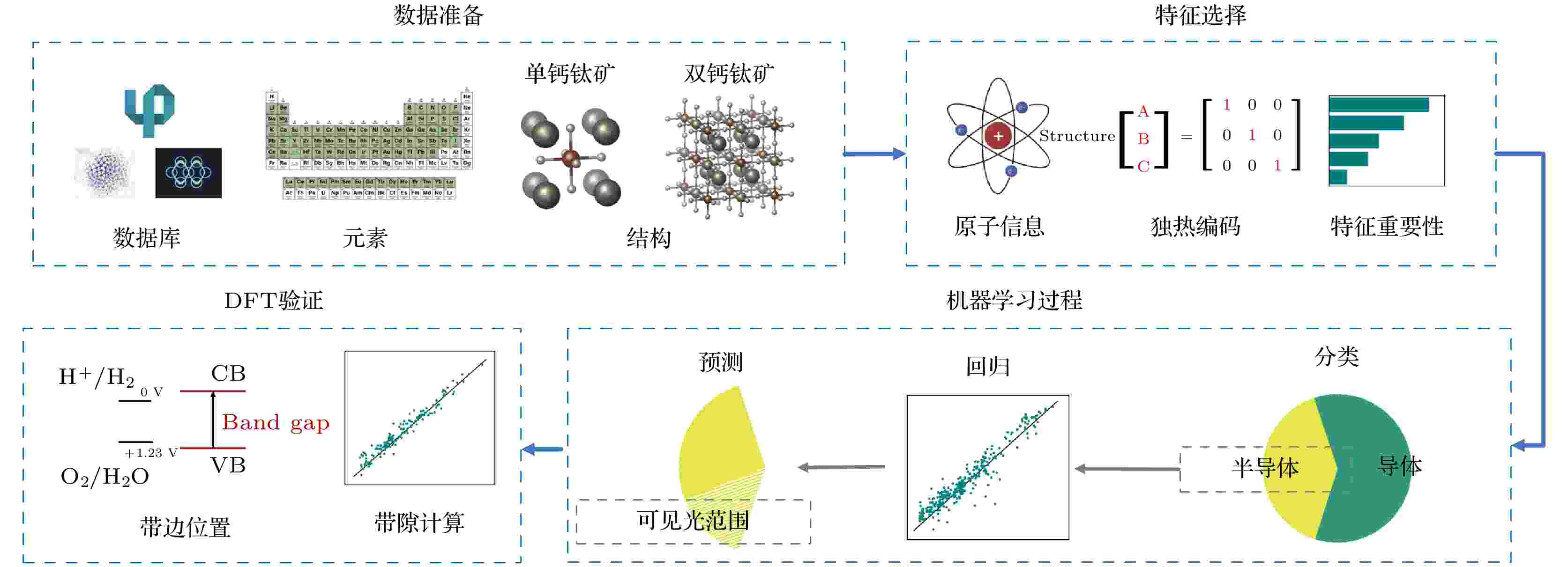
EDITOR'S SUGGESTION
2022, 71 (17): 177101.
doi:10.7498/aps.71.20220601
Abstract +
Double perovskite oxideA2BB'O6has better stability and wider bandgap range thanABO3-type oxide, and exhibits great prospects in photocatalytic overall water splitting. However, owing to the diversity of crystal structure and constituents of perovskite oxide, rapidly and accurately searching forA2BB'O6for photocatalyst is still a big challenge, both experimentally and theoretically. In this work, in order to screen out suitable double perovskite oxide photocatalysts, a multi-step framework combined with machine learning technique and first-principles calculations is proposed. Nearly 8000 candidates with proper bandgaps for water splitting are screened out from among more than 50000A2BB'O6-type double perovskite oxides. Statistical analysis of the results shows that double perovskite oxides with d10metal ions atB/B'sites are more likely to have good absorption of visible light, and the structural symmetry of double perovskite also has influence on the bandgap value. Furthermore, first-principles calculations demonstrate that Sr2GaSbO6, Sr2InSbO6and K2NbTaO6are non-toxic photocatalyst candidates with proper band edges for overall water splitting.
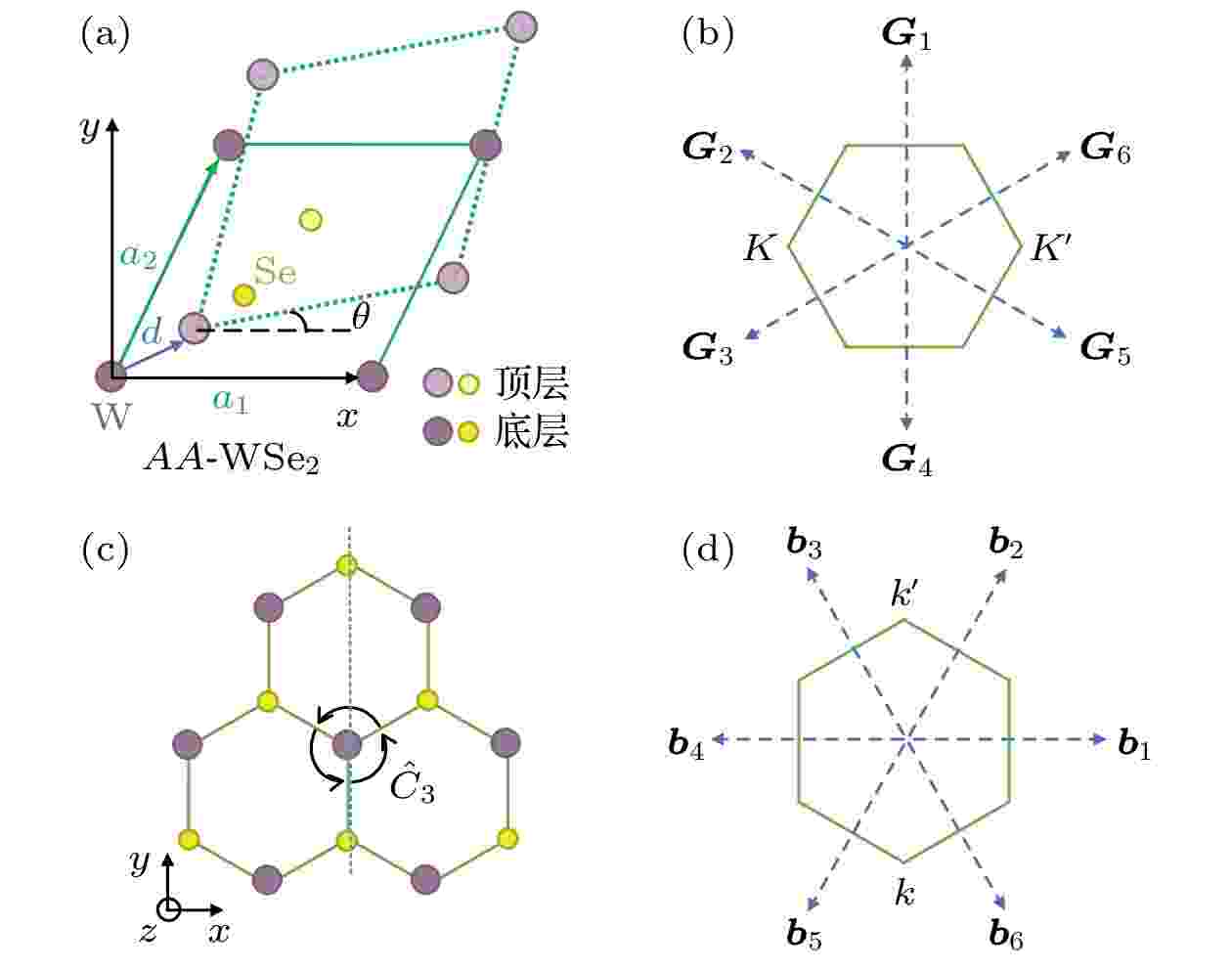
COVER ARTICLE
2022, 71 (17): 177301.
doi:10.7498/aps.71.20220664
Abstract +
The nanoscale periodic energy potential is introduced by moiré pattern in two stacked transition metal dichalcogenide monolayers with lattice mismatch or crystal orientation misalignment. It is demonstrated that the moiré potential can act as a diffusion barrier that affects interlayer exciton transport, providing an opportunity for studying the electronic and optical properties of moiré excitons. However, the current research on the modulation of exciton moiré potential in twisted homobilayers is limited. In this paper the effect of externally applied perpendicular electric field on the exciton moiré potential in twisted WSe2homobilayers with different rotation angles is studied by using first principle calculations. It is found that the amplitude and shape of the interlayer exciton moiré potential are dependent on the relative rotation angle between the layers and electric field intensity. The amplitude and shape of the moiré potential in the twisted WSe2homobilayers with different rotation angles vary with the electric field intensity (
$\leqslant $
1 V/nm). These results provide theoretical basis and data prediction for modulating the local and the non-local transition of interlayer excitons, and are of great significance in promoting the development of semiconductor devices such as artificial excitonic crystals and nanoarray lasers.
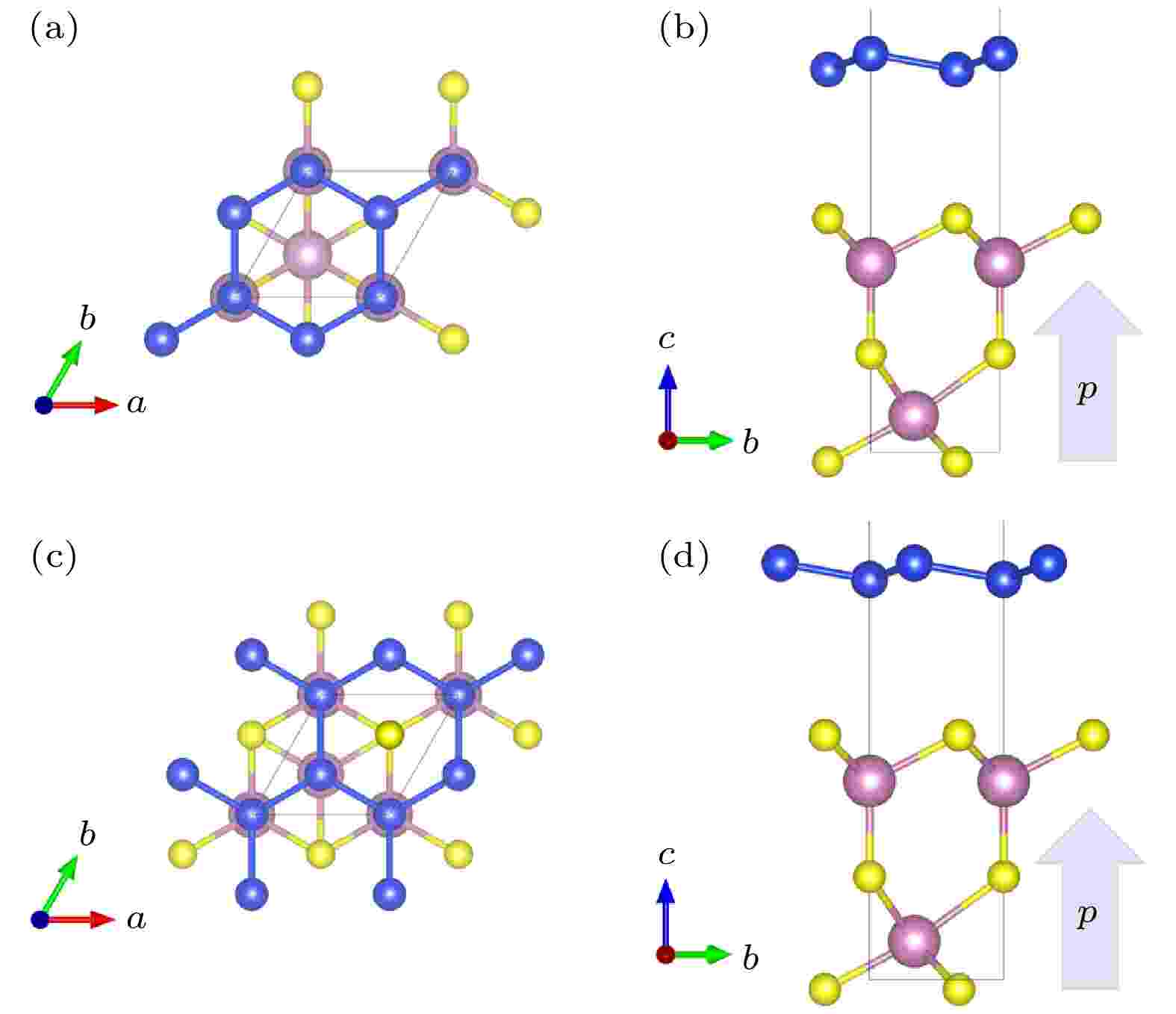
Control of electric properties of silicene heterostructure by reversal of ferroelectric polarization
2022, 71 (17): 177303.
doi:10.7498/aps.71.20220815
Abstract +
Silicene is a kind of two-dimensional material composed of a honeycomb arrangement of silicon atoms. Compared with the structure of graphene, the buckled structure of silicene weakens the
$\pi—\pi$
overlaps and turns the hybrid orbitals from
$\rm sp^2$
to
$\rm sp^3$
, which enhances the spin-orbit coupling strength but still preserves the Dirac cone nearKorK'. Owing to its buckled structure, silicene is susceptible to external parameters like electric field and substrate, which draws lots of attention both experimentally and theoretically. Recent progress of ferroelectricity in two-dimensional (2D) van der Waals materials found that the spontaneous ferroelectric polarization can be preserved even above room temperature, which inspires us to investigate how to tune the electric properties of silicene through the spontaneous polarization field of 2D ferroelectric substrate.
${\rm In_{2}}X_3$
(X= Se,S,Te) Family recently were found to have single ferroelectric monolayers with reversible spontaneous electric polarization in both out-of-plane and in-plane orientations, and the lattice mismatch between silicene and
$\rm In_{2}S_3$
is negligible. Therefore, we investigate the stacking and electric properties of silicene and monolayer
$\rm In_{2}S_3$
heterostructure by the first-principles calculations. The spontaneous polarization field of
$\rm In_{2}S_3$
is calculated to be 1.26
$\rm μC {\cdot} cm^{-2}$
, comparable to the experimental results of
$\rm In_{2}Se_3$
. We compare the different stacking order between silicene and
$\rm In_{2}S_3$
. The calculated results shown that theABstacking is the ground state stacking order, and the reversal of the ferroelectric polarization could tune the band structure of heterostructure. When the polarization direction of
$\rm In_{2}S_3$
is upward, the layer distance between silicene and
$\rm In_{2}S_3$
is 3.93 Å, the polarization field and substrate interaction together break theABsublattice symmetry and induce a 1.8 meV band gap near the Dirac point ofKandK', while the Berry curvature aroundKandK'have opposite signs, corresponding to valley Hall effect. When the polarization is downward, the layer distance decreases to 3.62 Å and the band gap aroundKandK'both increase to 30.8 meV. At the same time a 0.04echarge transfer makes some bands move across the Fermi energy, corresponding to metal state. Our results pave the way for studying the ferroelectric tuning silicene heterostructures and their potential applications in information industry.
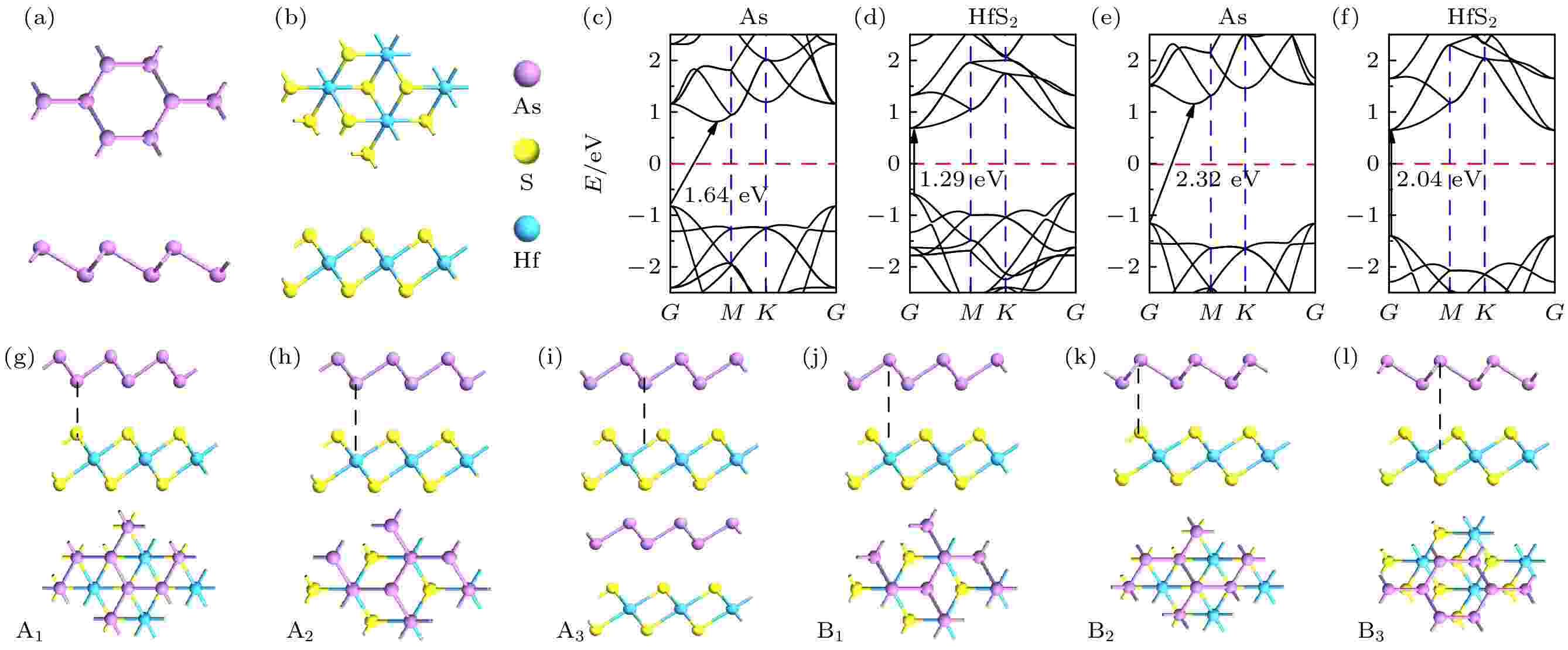
Electronic and optical properties and quantum tuning effects of As/Hfs2van der Waals heterostructure
2022, 71 (17): 177304.
doi:10.7498/aps.71.20220371
Abstract +
Stacking two or more monolayer materials to form van der Waals heterostructures is an effective strategy to realize ideal electronic and optoelectronic devices. In this work, we use As and HfS2monolayers to construct As/Hfs2heterostructures by six stacking manners, and from among them the most stable structure is selected to study its electronic and optic-electronic properties and quantum regulation effects by hybrid functional HSE06 systematically. It is found that the As/Hfs2intrinsic heterostructure is a II-type band aligned semiconductor, and its band gap can be significantly reduced (~ 0.84 eV) in comparison with two monolayers (band gap > 2.0 eV), especially the valence band offset and conduction band offset can increase up to 1.48 eV and 1.31 eV, respectively, which is very favorable for developing high-performance optoelectronic devices and solar cells. The vertical strain can effectively adjust the band structure of heterostructure. The band gap increases by tensile strain, accompanied with an indirect-direct band gap transition. However, by compressive strain, the band gap decreases rapidly until the metal phase occurs. The applied external electric field can flexibly adjust the band gap and band alignment mode of heterostructure, so that the heterostructure can realize the transformation between I-, II-, and III-type band alignments. In addition, intrinsic As/Hfs2heterostructure has ability to strongly absorb light in the visible light region, and can be further enhanced by external electric field and vertical strain. These results suggest that the intrinsic As/Hfs2heterostructure promises to have potential applications in the fields of electronic, optoelectronic devices and photovoltaic cells.
INTERDISCIPLINARY PHYSICS AND RELATED AREAS OF SCIENCE AND TECHNOLOGY

2022, 71 (17): 178101.
doi:10.7498/aps.71.20220652
Abstract +
In practical applications, the performances of conventional metal-insulator-metal (MIM) waveguide structured optical devices cured during fabrication are not dynamically tunable. In order to address the problem that such devices are not dynamically tunable, based on the excellent optoelectronic properties of graphene materials, graphene nanotubes are induced into the metal-insulator-metal waveguide coupled circular resonant cavity structure, thus designing a dynamically tunable MIM-graphene nanotube hybrid structure refractive index sensor in this work. The finite element method (FEM) is used to numerically study the transmission characteristics, electric field distribution and magnetic field distribution of the system, and the theoretical analysis is performed by multimode interference coupled mode theory (MICMT) to verify its correctness. The results show that after adding graphene nanotube to the MIM waveguide coupled ring resonant cavity structure, a Fano resonance peak appears in this system, which originates from the coherent coupling between the TM10cavity resonance mode and the graphene plasmonic electrical resonance mode. The sensor can dynamically tune the resonance wavelength and linewidth of Fano resonance in a wide wavelength range by changing the chemical potential of graphene, thus realizing the performance tuning of the refractive index sensor. Hence, the problem that the conventional plasma refractive index sensor is not dynamically tunable issolved. In addition, the influence of the geometrical parameters of the structure on the sensing performance of this system is also studied in detail. The sensor sensitivity increases up to 1250 nm/RIU and the quality factor rises up to 42.4 RIU–1at the optimal structural parameters. Compared with the traditional metal-insulator-metal waveguide structure design, this device has many merits such as wide operating band range, easy processing and dynamic tunability, which is a guideline for designing the dynamically tunable high performance nano-photonic integrated devices.
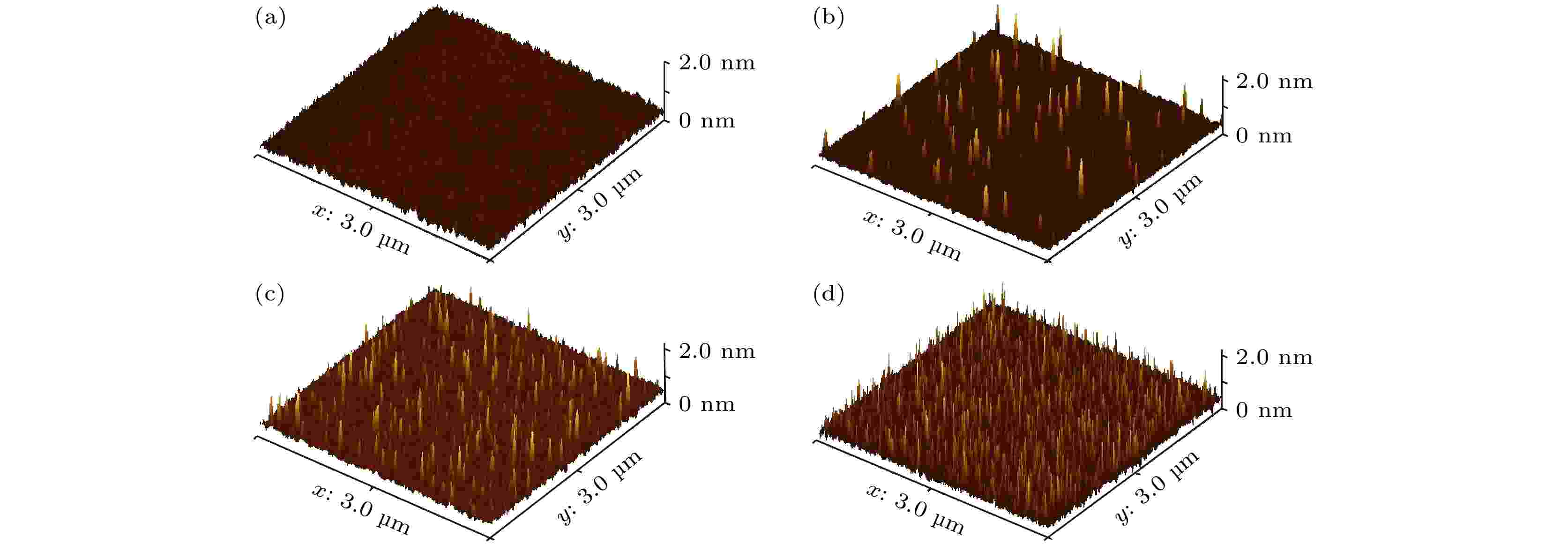
2022, 71 (17): 178102.
doi:10.7498/aps.71.20220189
Abstract +

2022, 71 (17): 178103.
doi:10.7498/aps.71.20220736
Abstract +
Transition metal oxides have been a research hotspot for basic scientific research and frontier applications. Owing to the presence of d
$\rho \text{-} T$
curve measurements and fitting results show that the epitaxial BaMoO3films on SrTiO3(001) substrates have better conductivities. The electrical transport properties of BaMoO3films grown on SrTiO3(111) substrates are dominated by electron-phonon scattering, and BaMoO3films grown on SrTiO3(001) substrate have stronger electron-electron scattering interactions. The resistivity of the self-assembled superlattice BaMoO3films is relatively high and electron-electron scattering plays an important role in determining the electrical transport property.
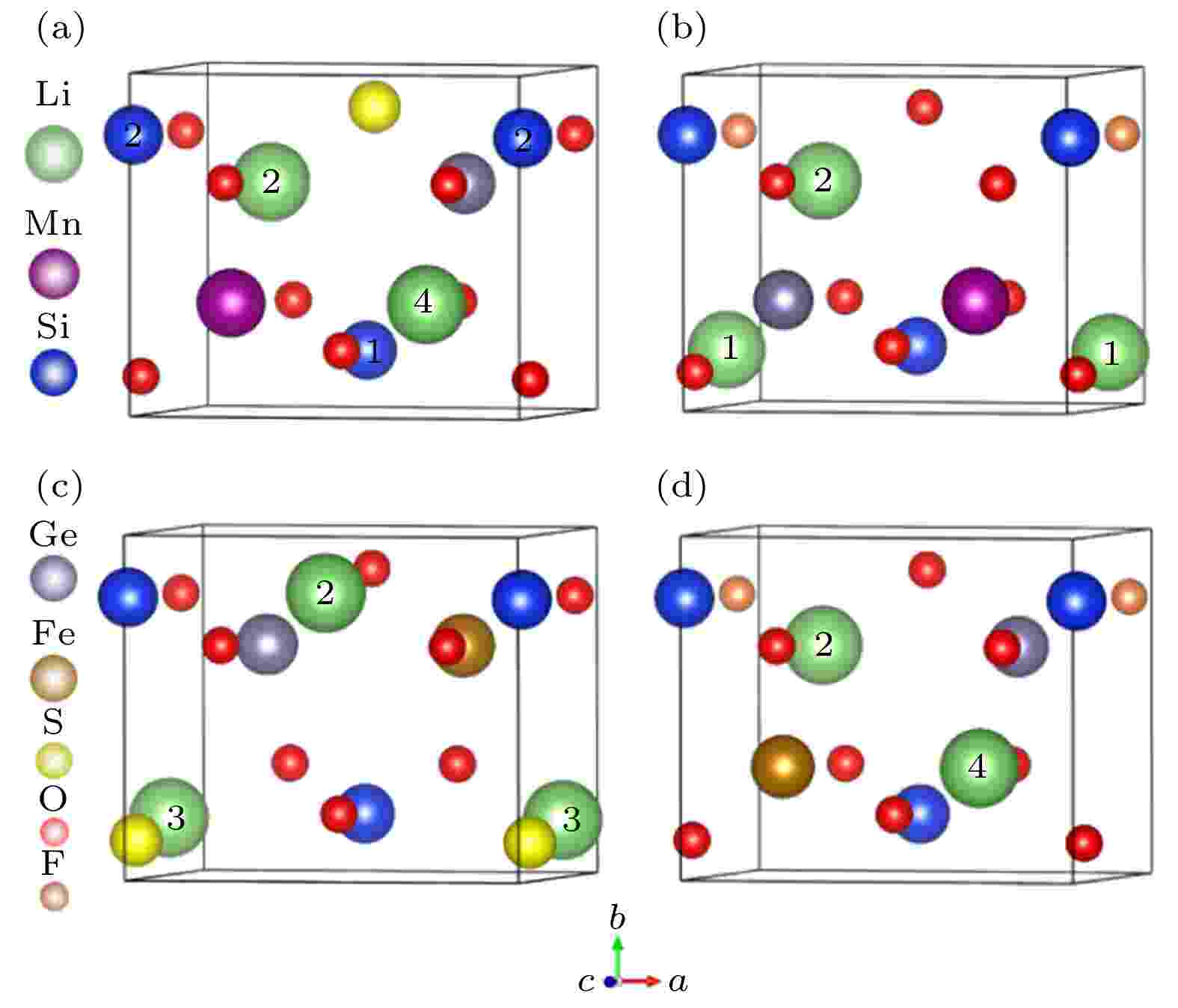
2022, 71 (17): 178201.
doi:10.7498/aps.71.20220473
Abstract +
The effects of Ge-S/F co-doping on the structural stability and electrochemical properties of Li2MSiO4(M= Mn, Fe) crystal are systematically studied by the first-principle calculations based on density functional theory combined with the generalized gradient approximation (GGA) +Umethod. The calculation results show that the Ge-S/F co-doping Li2MSiO4(M= Mn, Fe) system undergoes the site exchange between Li and M in the delithiation process. Compared with Li2MSiO4(M= Mn, Fe), the doped system has good toughness, and lithium ions migrate easily in the doped system. And the doped system with site exchange is more stable in the process of delithium, especially the volume change of Li2Mn0.5Ge0.5SiO3.5S0.5is very small, indicating that it has good structural cyclic stability. Moreover, the theoretical average deintercalation voltages of Li2MSiO4(M= Mn, Fe) are reduced by Ge-S/F co-doping. The combination of the density of states with magnetic moment shows that the Ge-S/F co-doping can improve the conductivity of Li2MnSiO4and delay the appearance of the Jahn-Teller effect in the Li2MnSiO4system, which is beneficial to the improvement of the structural cycling stability of Li2MnSiO4. Meanwhile, the Ge-S/F co-doping can not only improve the conductivity of Li2FeSiO4, but also facilitate the removal of more Li+from Li2FeSiO4system, especially the complete delithium of Ge-F co-doping system is expected to be achieved.
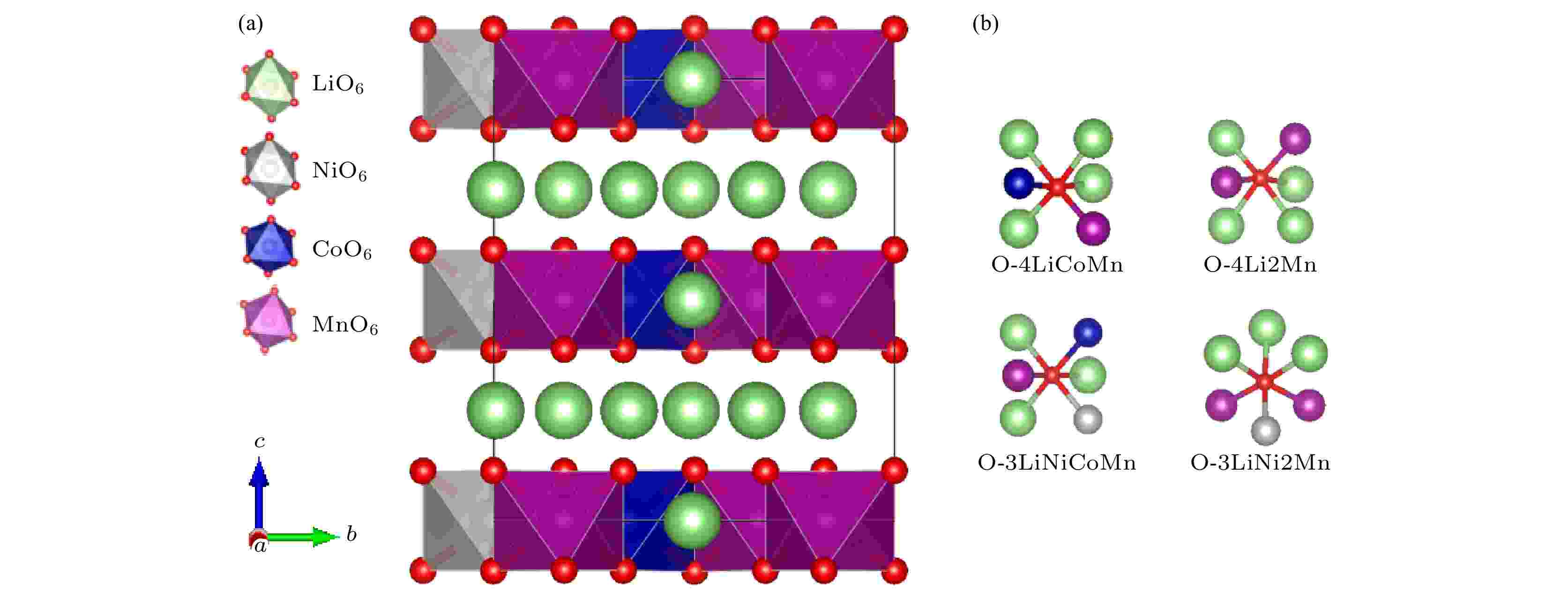
2022, 71 (17): 178202.
doi:10.7498/aps.71.20220274
Abstract +
Using the first-principles method based on the density functional theory, the oxygen vacancy formations in the lithium-rich manganese-based ternary cathode material Li1.167Ni0.167Co0.167Mn0.5O2are calculated. The changes of oxygen vacancy formation energy with temperature, oxygen partial pressure and point defects in the material are discussed, meanwhile, the effect of oxygen vacancies on the capacity is also discussed. The calculation results show that the increase of temperature and the decrease of oxygen partial pressure can lead the formation energy of an oxygen vacancy to decline. For the charged oxygen vacancies (
$ {\mathrm{V}}_{\mathrm{O}}^{+1} $
,
$ {\mathrm{V}}_{\mathrm{O}}^{+2} $
), the formation energy of an O-vacancy increases with Fermi level increasing. It is also found that the presence of an oxygen vacancy will trigger off a very local charge density redistributions, mainly around the neighboring Mn ions next to the O-vacancy. Furthermore, the effects of point defects, including cation vacancies and substitutional defects in the vicinity of the O-vacancy, on the formation energy of O-vacancy are also calculated. The results show that the presence of Mn vacancy near the O-vacancy is beneficial to the formation of the O-vacancy. In addition, the formation of oxygen vacancy is suppressed when the Mn atoms near the O-vacancy are substituted by the Mo or Fe atoms.

EDITOR'S SUGGESTION
2022, 71 (17): 178501.
doi:10.7498/aps.71.20220818
Abstract +
In order to prepare high-quantum-efficiency semiconductor Cs-Te photocathode which can produce a high-quality electron source, based on the INFN-LASA Cs-Te photocathode preparation method, the Cs-Te photocathode preparation method with Te intermittent, Cs continuous deposition is developed. The Cs-Te photocathode with quantum efficiency greater than 5% under 265 nm UV irradiation is successfully prepared in the photocathode preparation device of SINAP and SARI, and the fabrication success rate reaches 100%. As long as the preparation chamber vacuum degree is better than 10–8Pa, the Cs-Te photocathode with high quantum efficiency can be prepared by this preparation method, which will not be different due to the changes of preparation equipment and operators.

2022, 71 (17): 178701.
doi:10.7498/aps.71.20212400
Abstract +
In order to solve the problems of large, uncontrollable insertion loss and small phase shift of the existing terahertz phase shifters, in this work a kind of terahertz phase shifter realized by a simple metamaterial composite structure is designed. The device is composed of four layers in structure, they from top to bottom, being an L-shaped metal resonance layer, a liquid crystal layer, a bow-shaped metal layer, and a quartz substrate layer. By applying a bias voltage to the upper metal layer and the lower metal layer, the deflection angleαof the director of liquid crystal molecules in the liquid crystal cell is changed, so that the effective refractive index of the liquid crystal changes, and the phase of the device also changes accordingly, thereby achieving the purpose of dynamic phase control. The performances of the upper metal layer, the lower metal layer and liquid crystal layer are optimized and compared with each other. The performance characteristics of the phase shifter under different values of deflection angleαand different values of incident angleθare analyzed by frequency domain finite integration method. Through the simulation optimization and comparison of the size of the upper and lower metal layers and the thickness of the liquid crystal layer, the optimum is obtained. The simulation results show that the transmittance of the terahertz liquid crystal phase shifter can reach 0.968 in a frequency between 1.68–1.78 THz, and the insertion loss can be as low as 0.3 dB. When the frequency is 1.7396 THz, the maximum phase shift of the terahertz phase shifter is 352.625°. The phase shift exceeds 352° in a frequency range of 1.7315–1.7396 THz (Bandwidth is 8.1 GHz). This simple metamaterial multilayer structure provides a new method of controlling terahertz waves, and has broad application prospects in terahertz imaging, sensing and other fields.
GEOPHYSICS, ASTRONOMY, AND ASTROPHYSICS
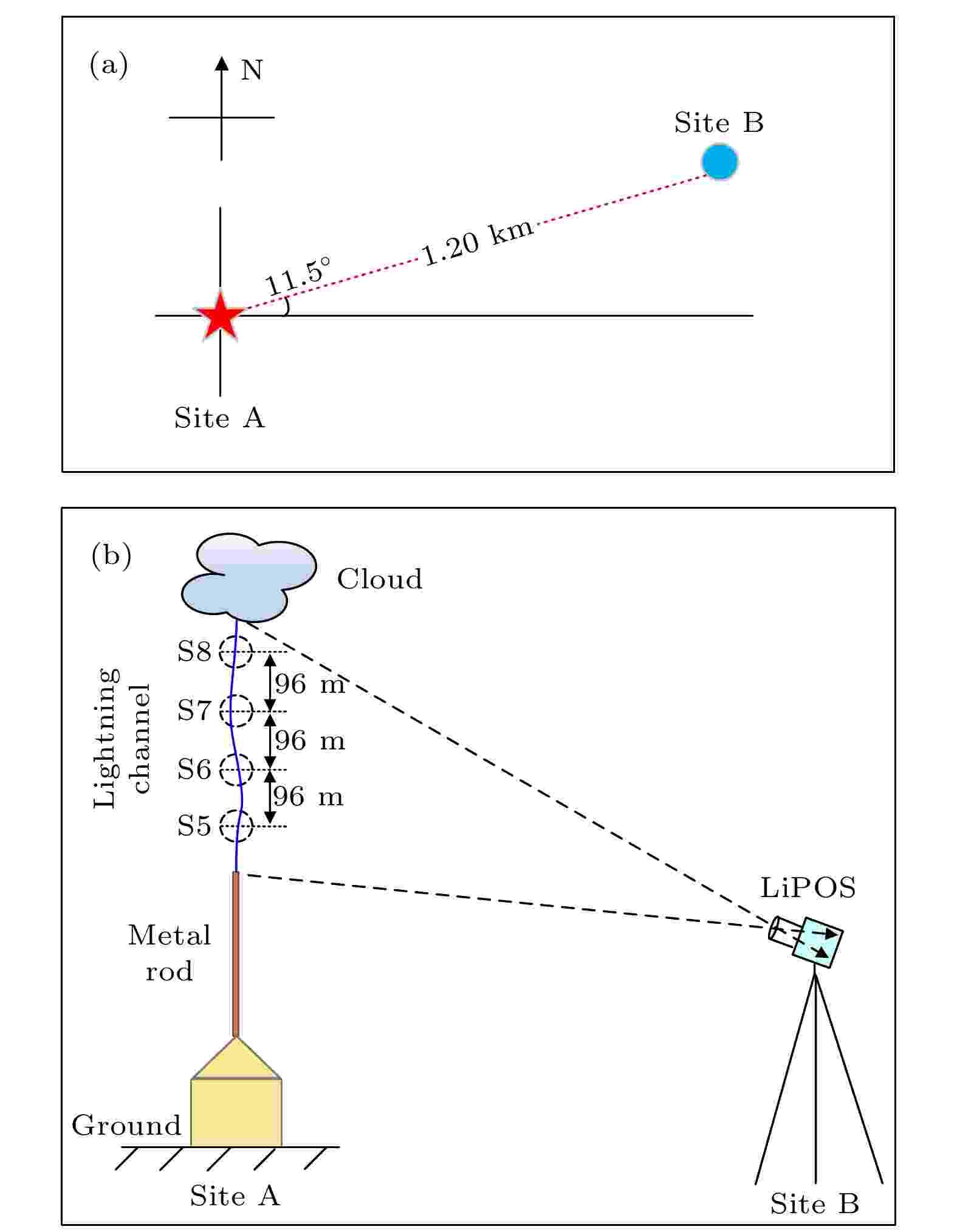
2022, 71 (17): 179201.
doi:10.7498/aps.71.20220479
Abstract +
In this paper, improved continuous wavelet transform is used to analyze the dispersion characteristics of a group of optical radiation signals of return stroke in an artificially triggered lightning, and the analysis results are compared with the results calculated by the classicalR-L-Ctransmission line model. The analysis results show that the arrival time of different frequency components of the optical radiation of return stroke presents nonlinear variation with frequency. Moreover, a turning point always appears in the low frequency band on the arrival time curves of different frequency components, and the turning frequency is usually between 10 kHz and 25 kHz. The existence of this turning frequency provides a new kind of parameterization basis for evaluating the characteristic and conductivity of the return stroke channel. Based on this, the channel conductivities of the six return strokes of this triggered lightning are estimated. The average variation ranges from 0.59 × 104S/m to 0.96 × 104S/m, and the overall average value is about 0.77 × 104S/m, which are similar to the classical evaluation results.





























